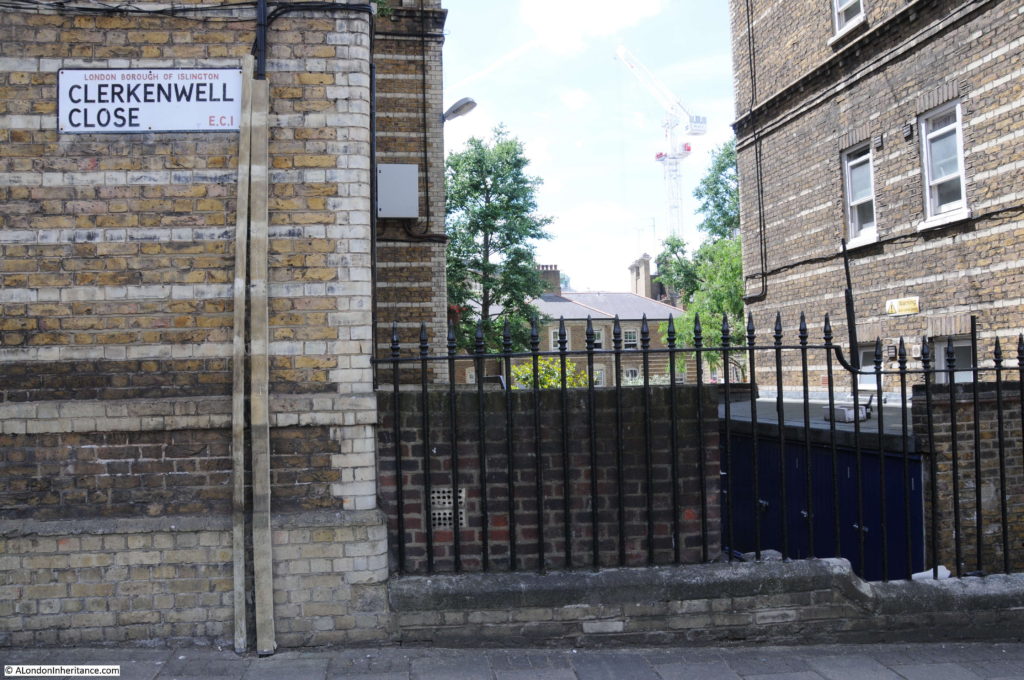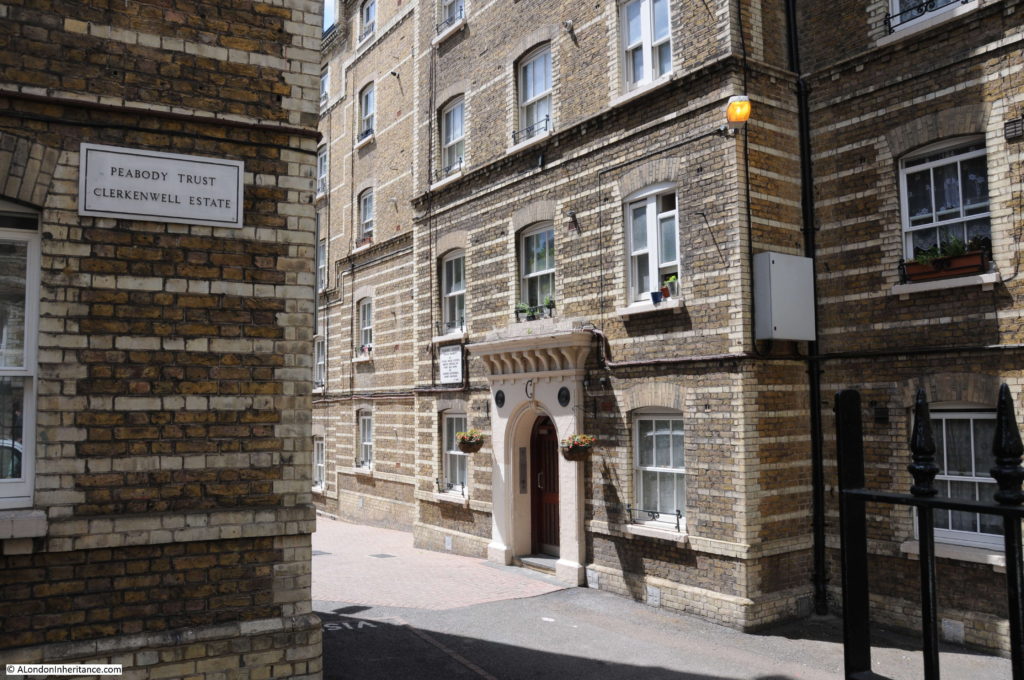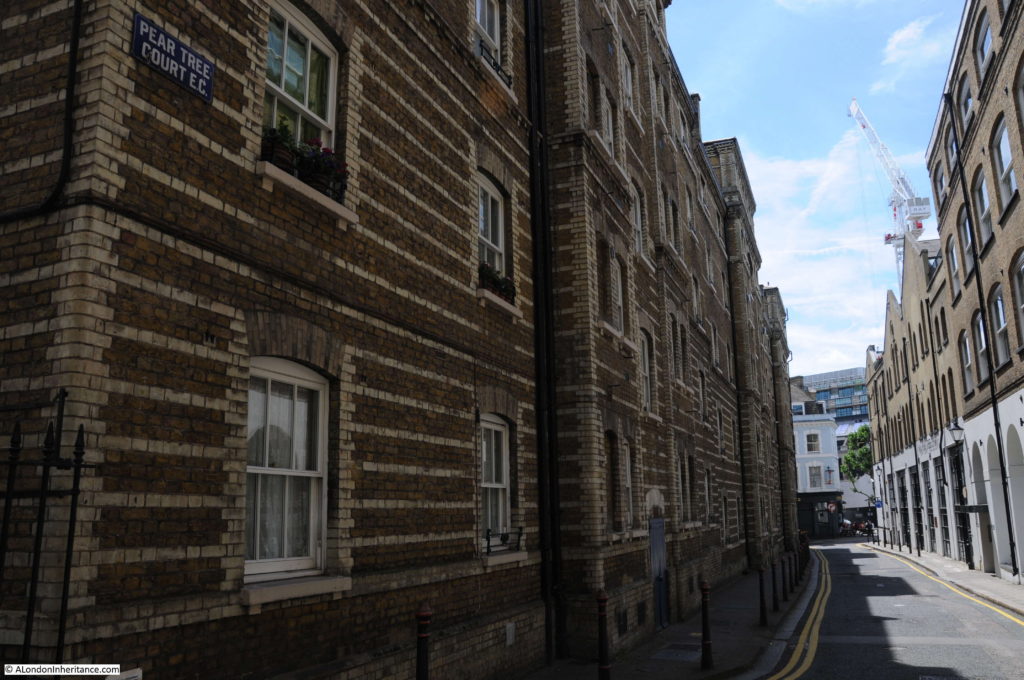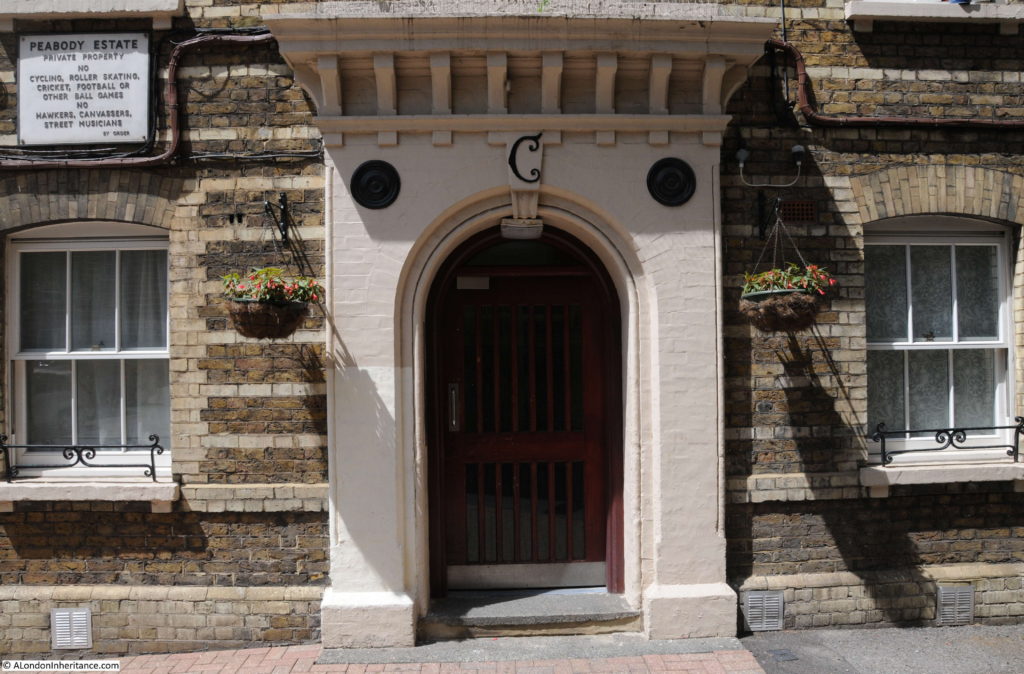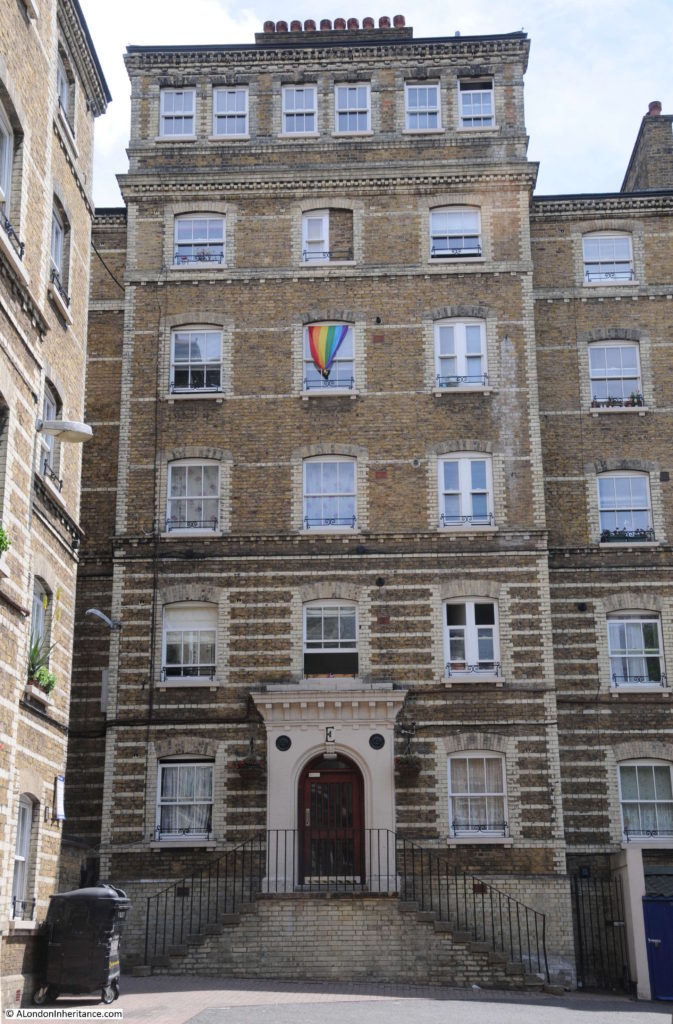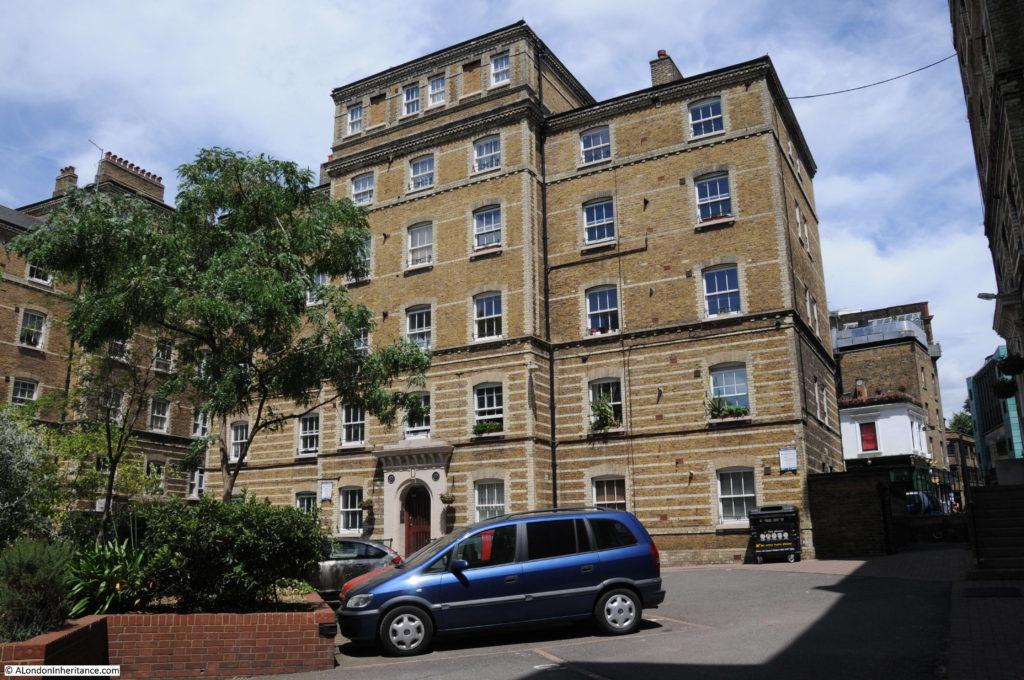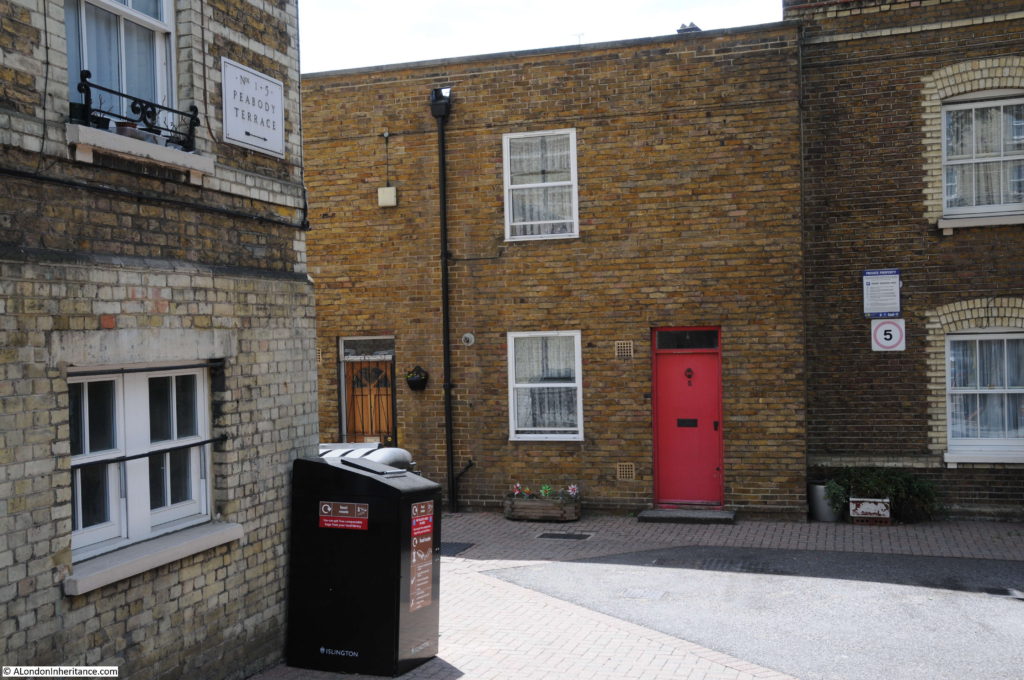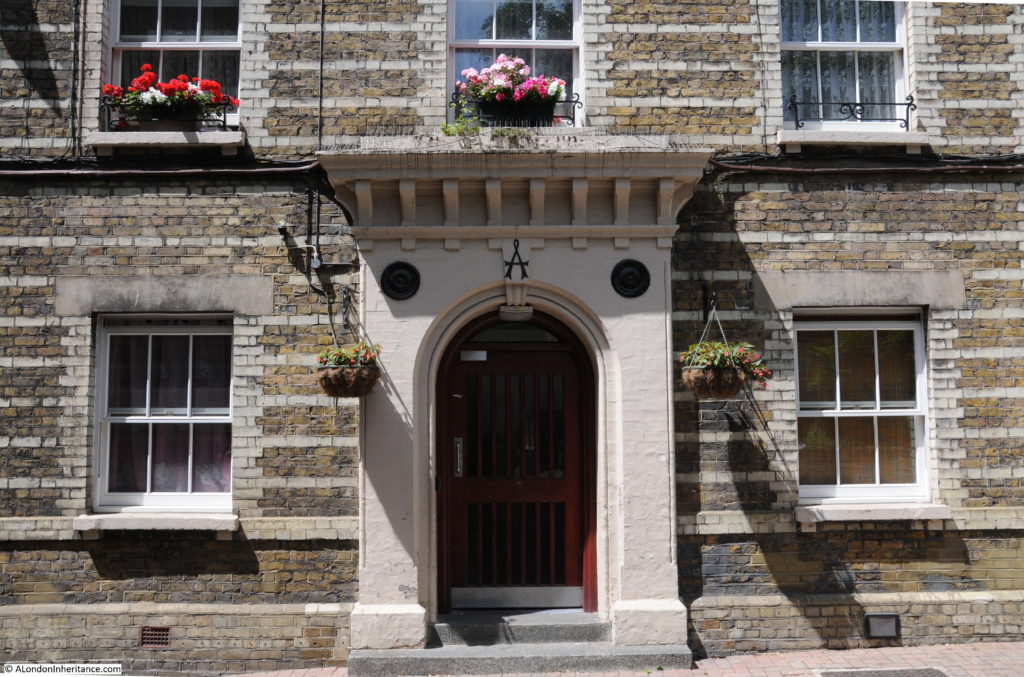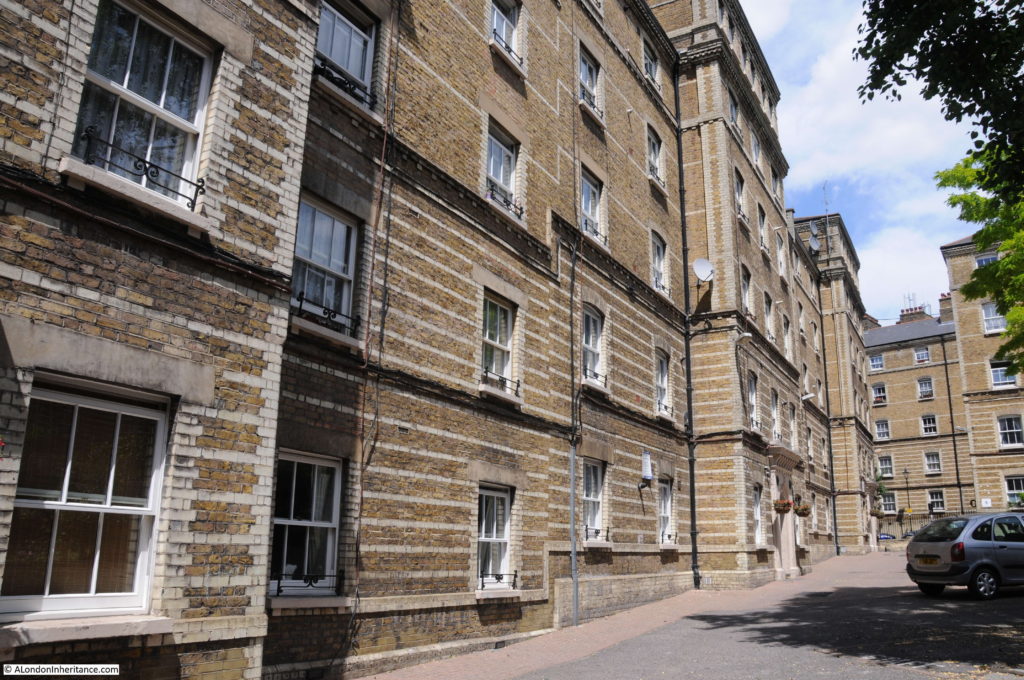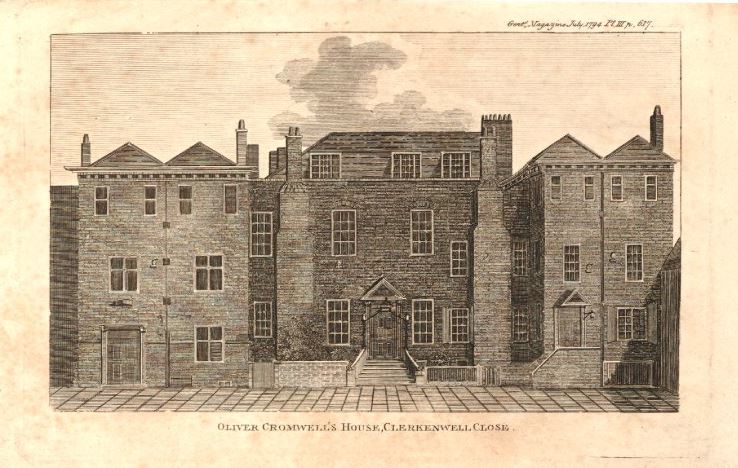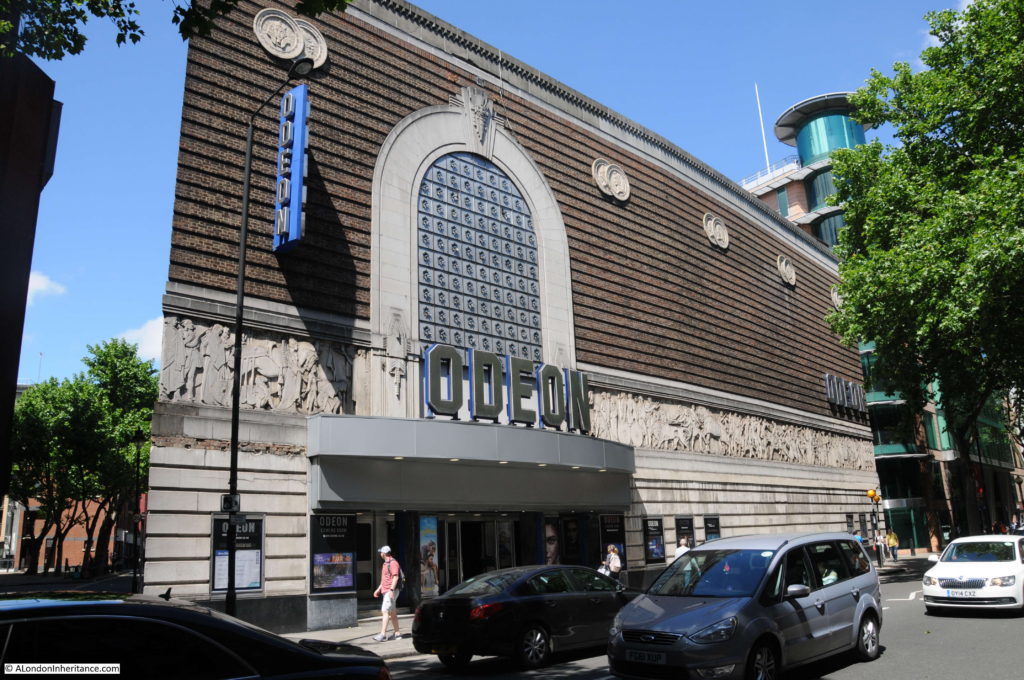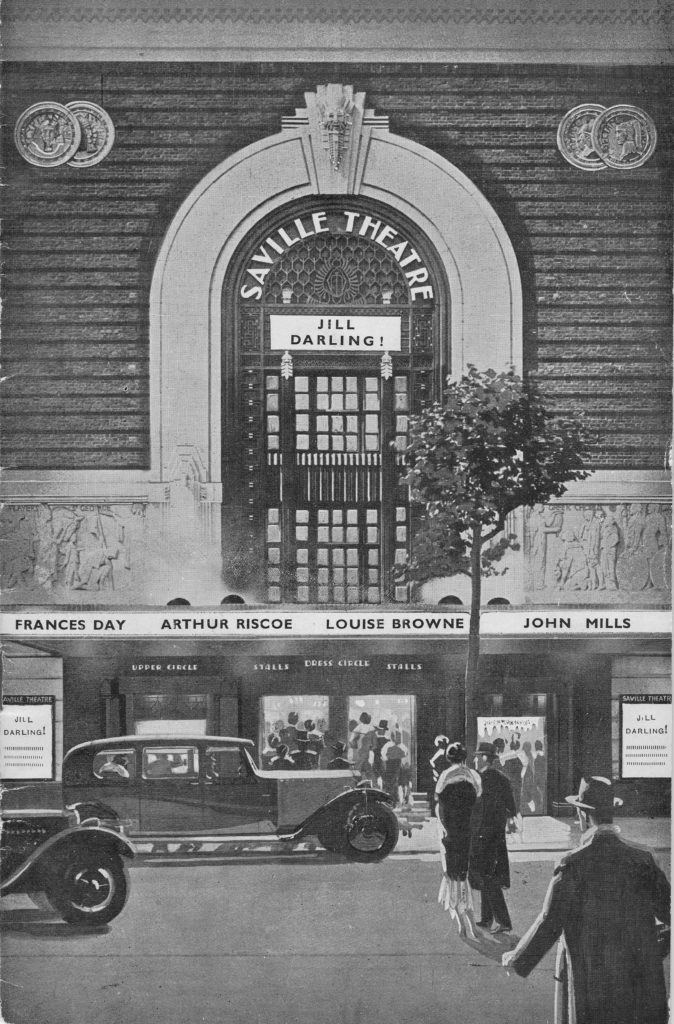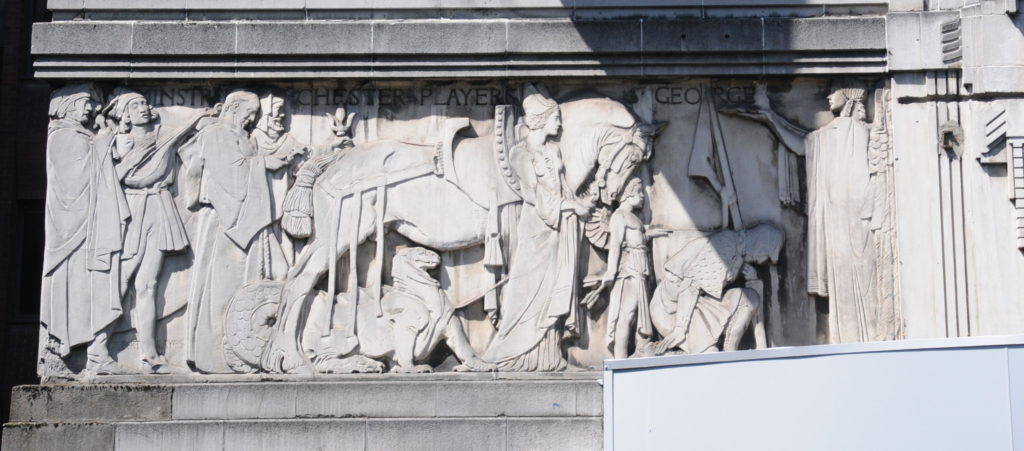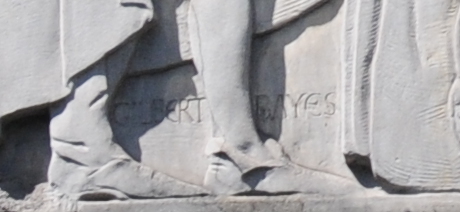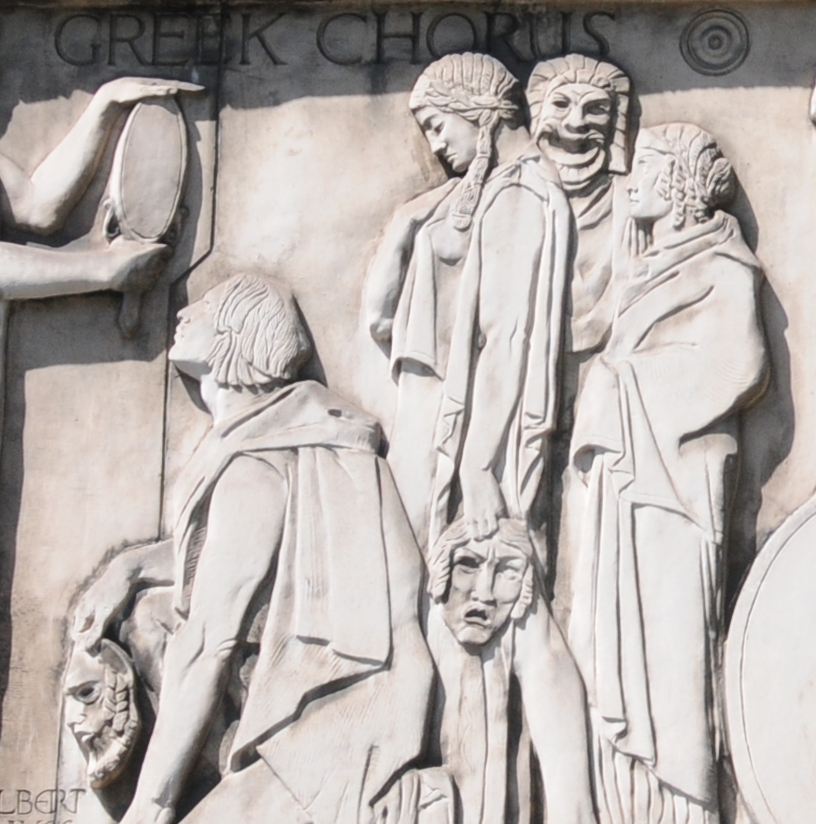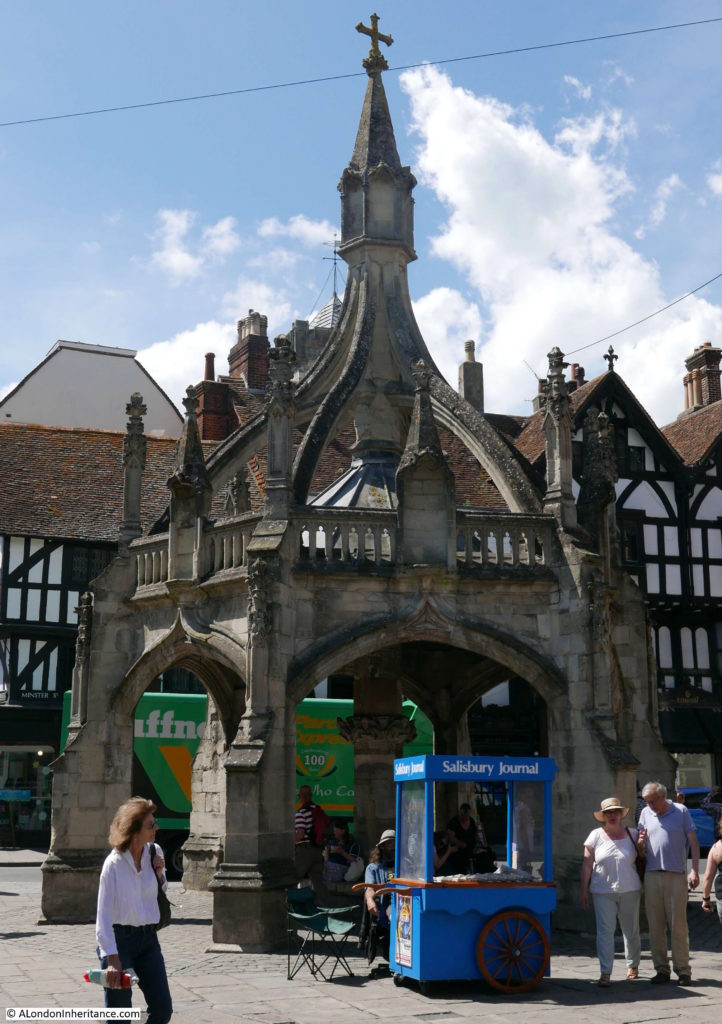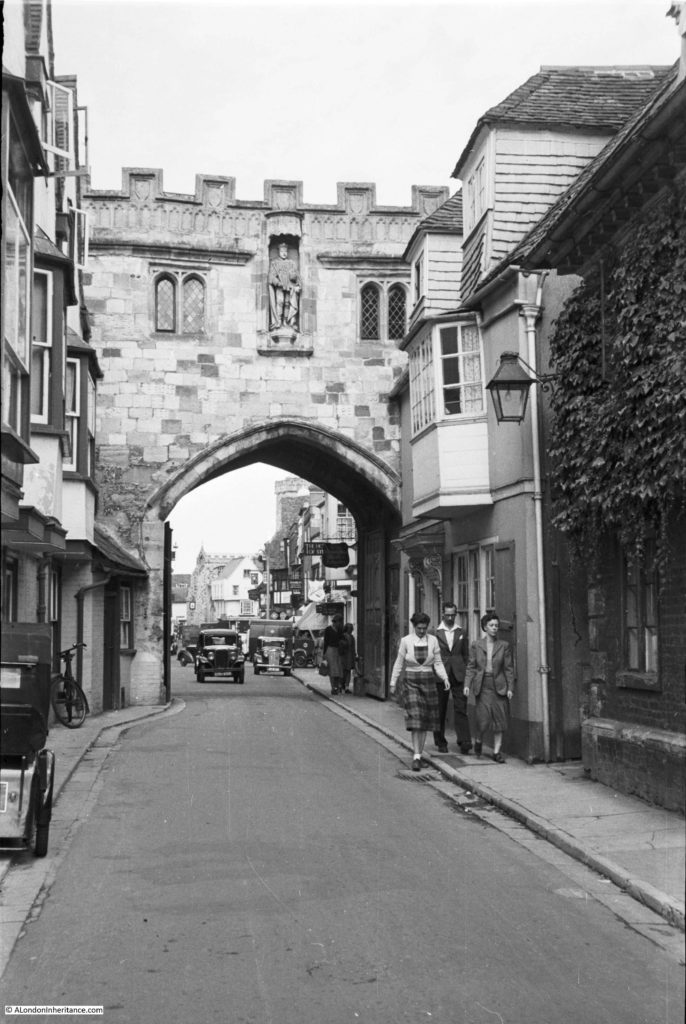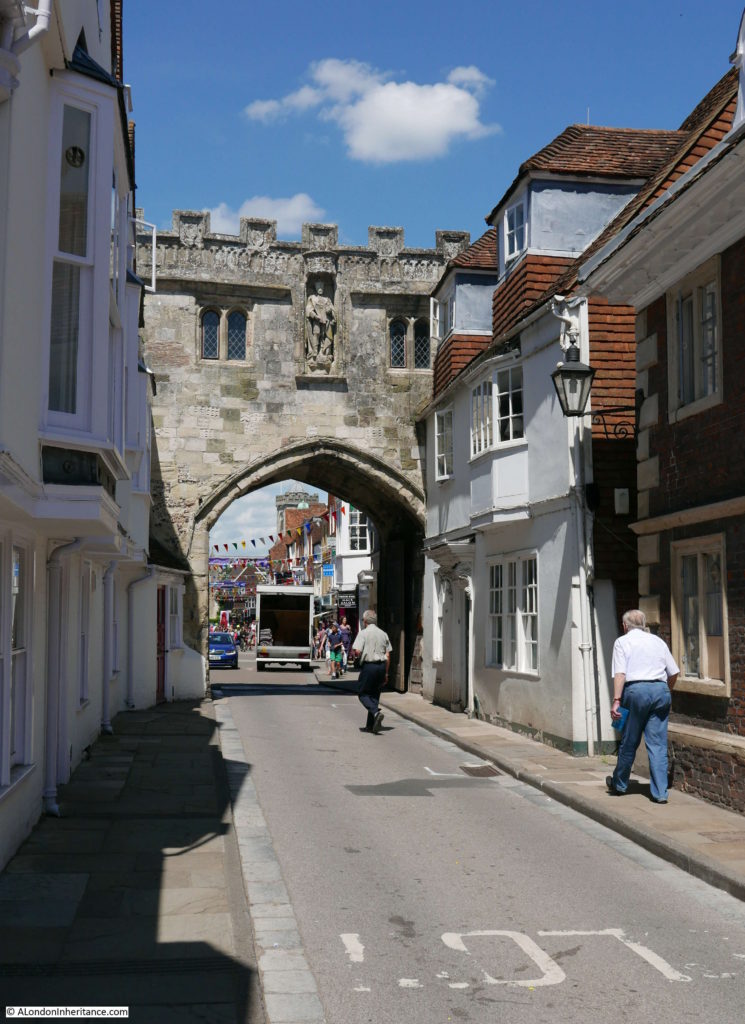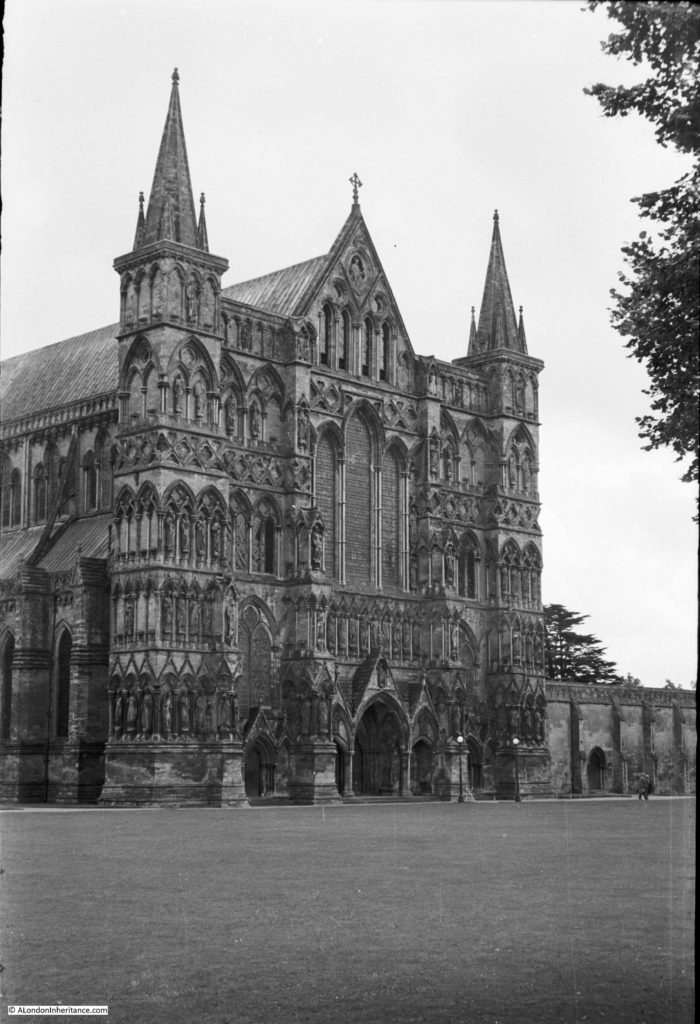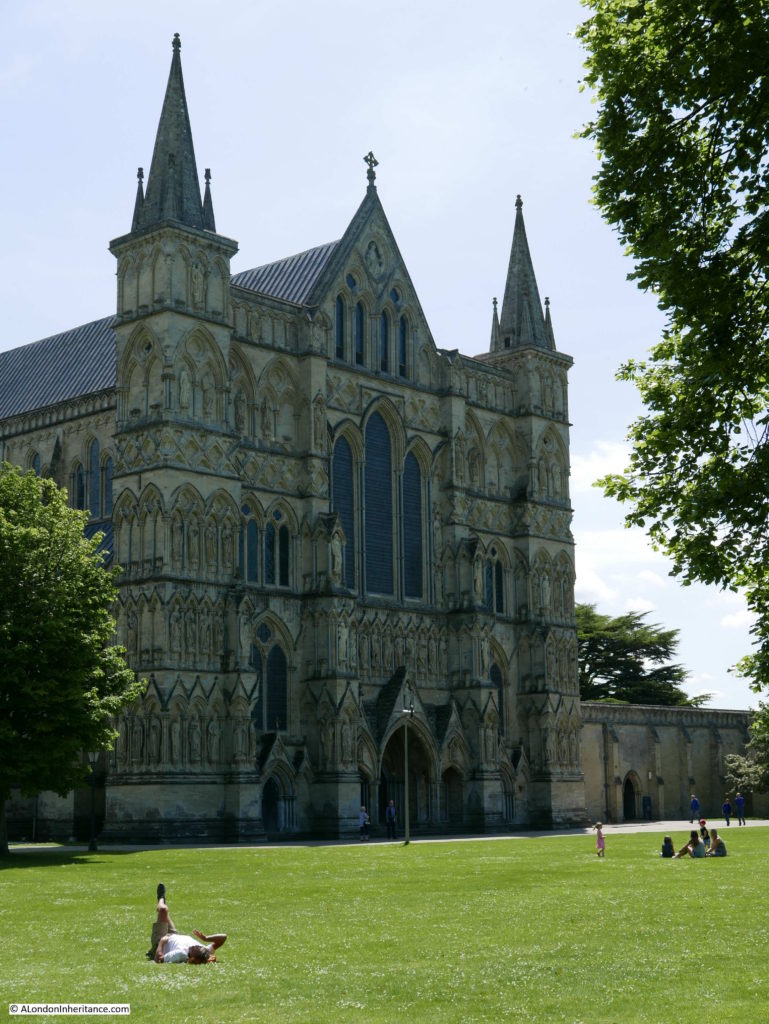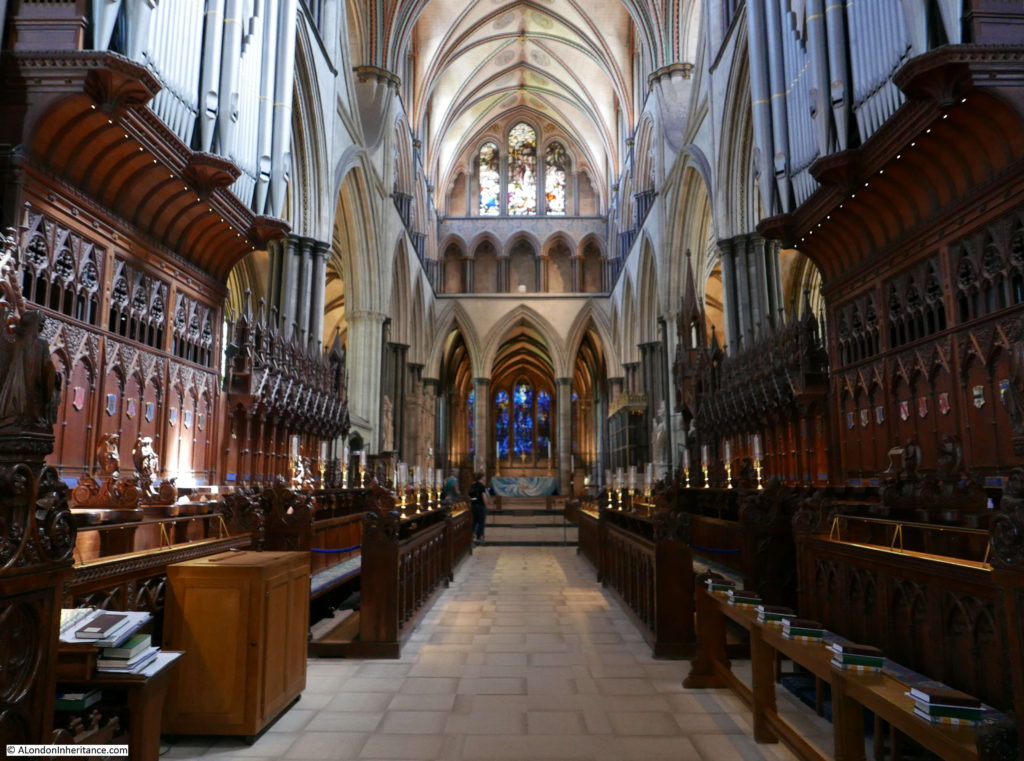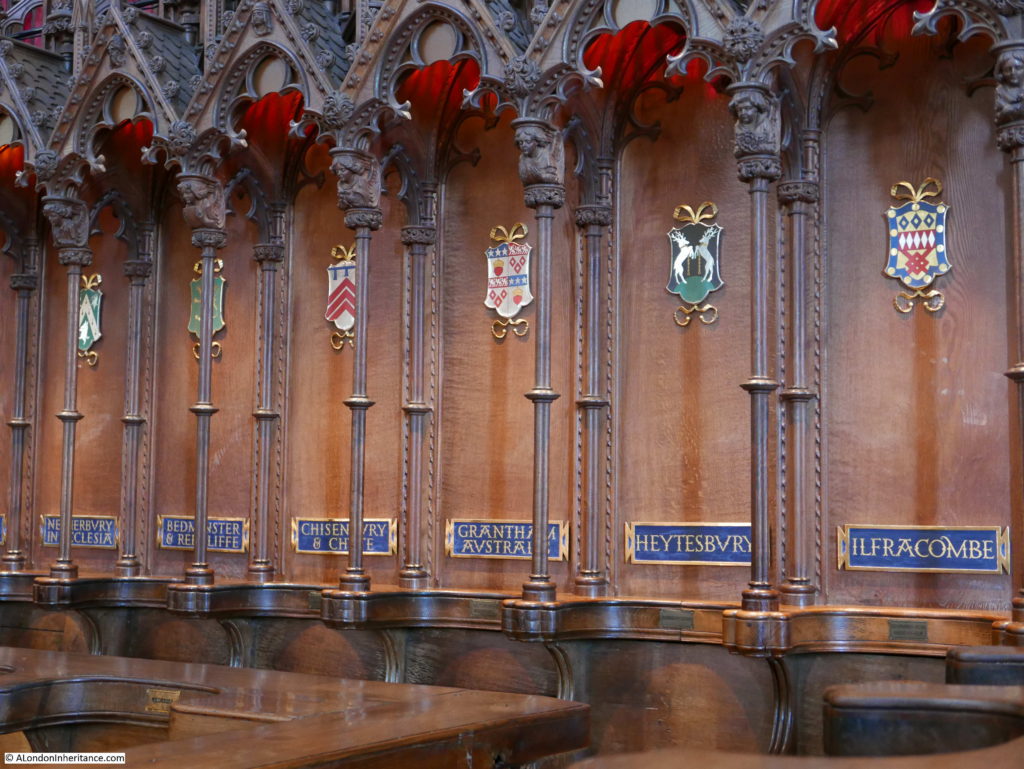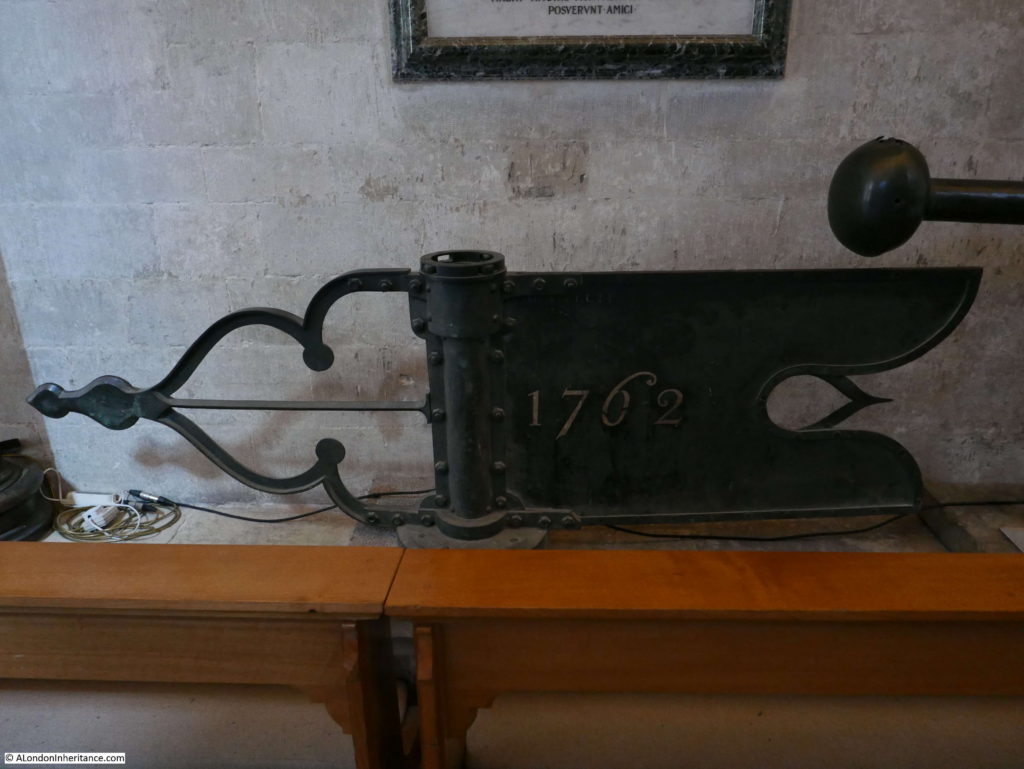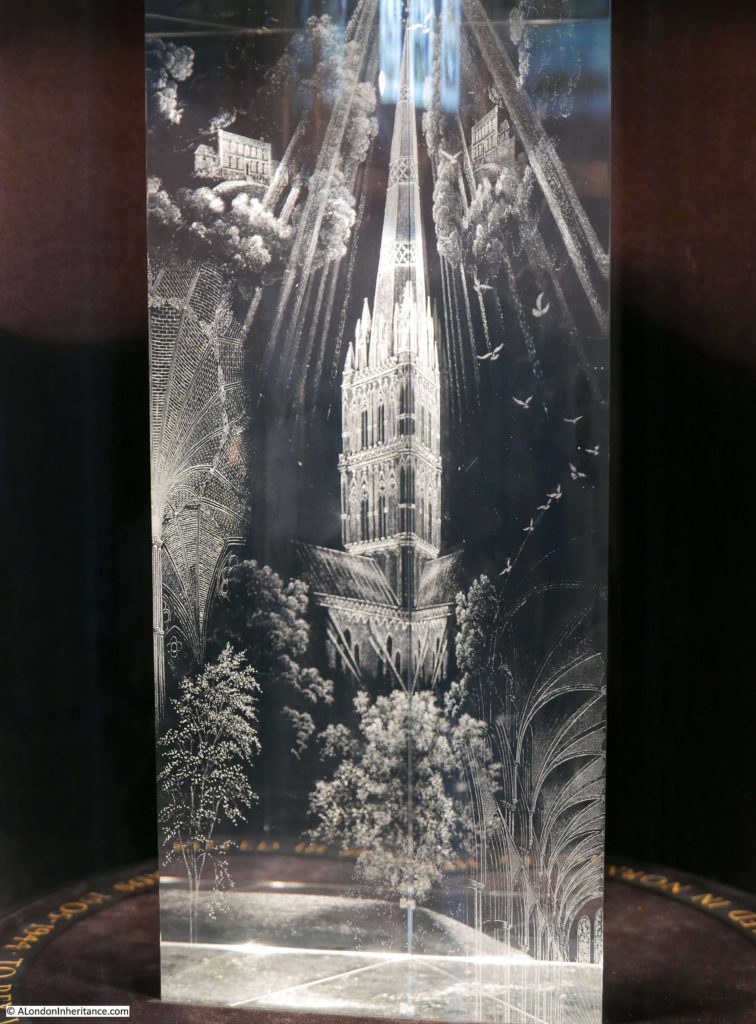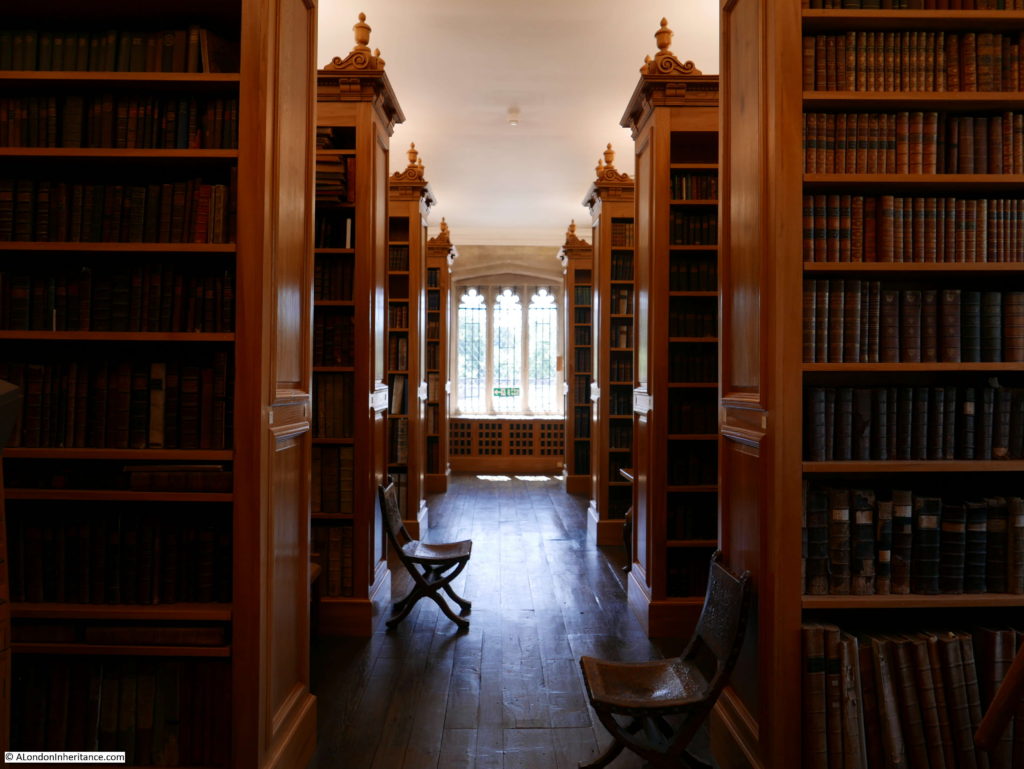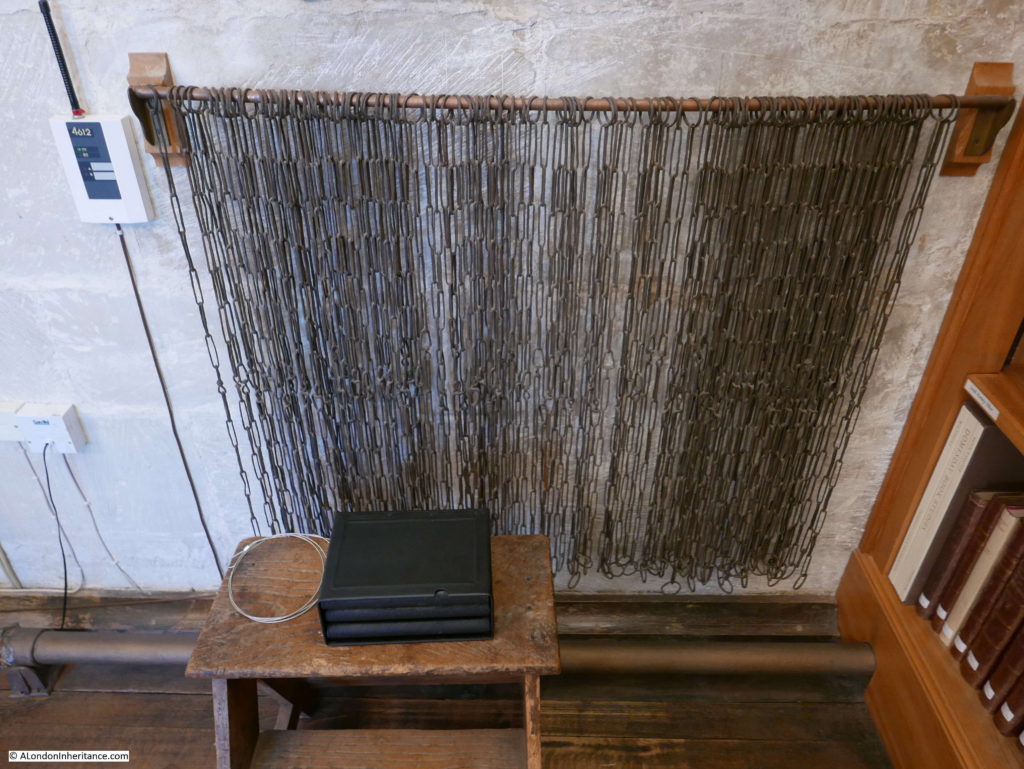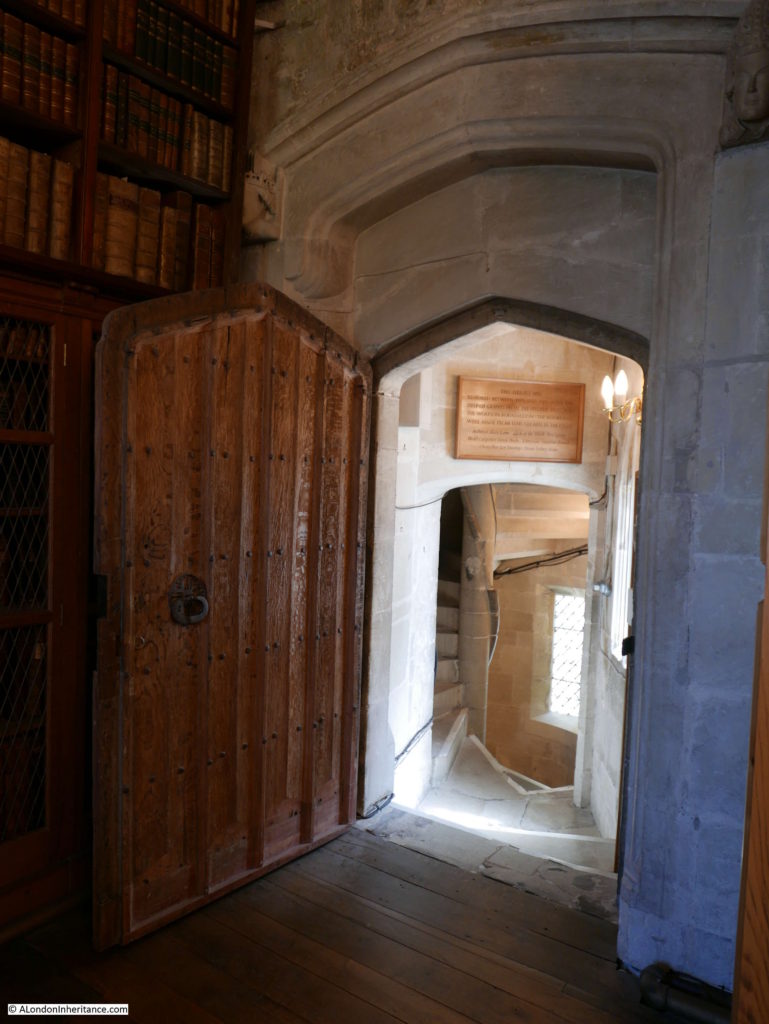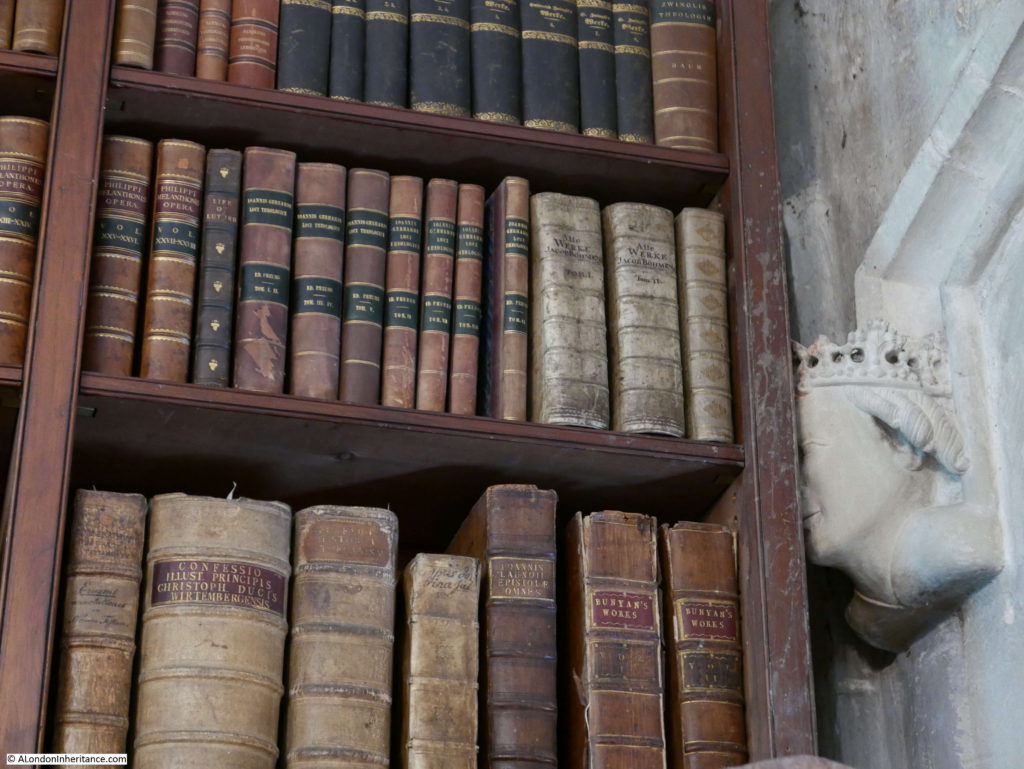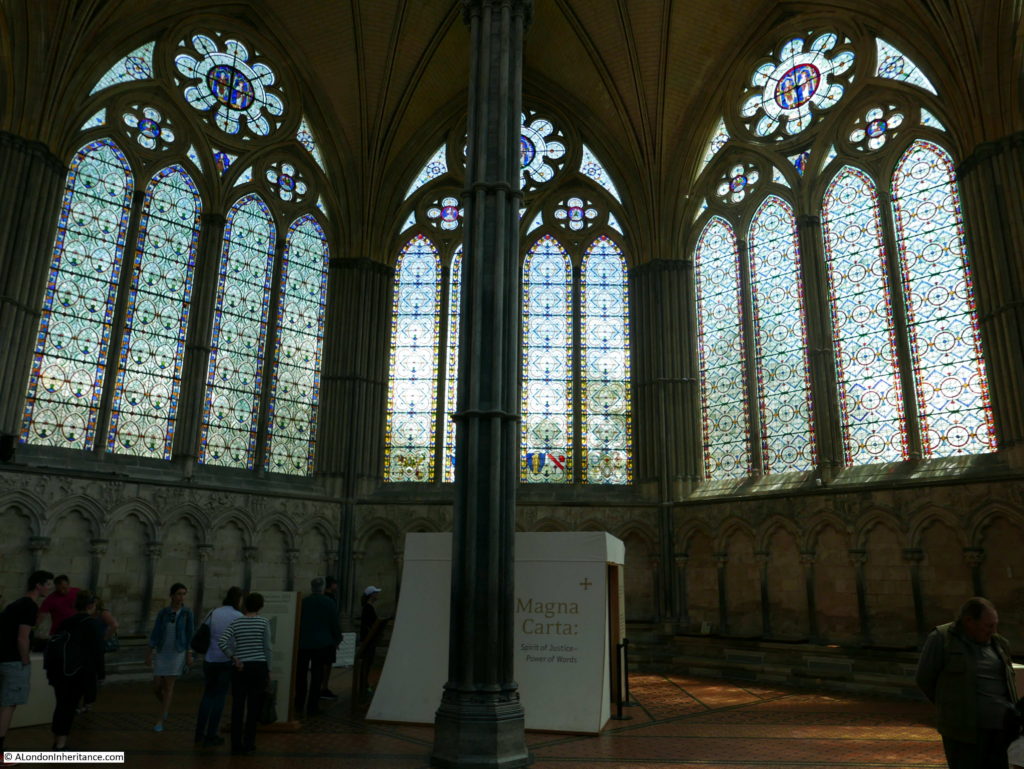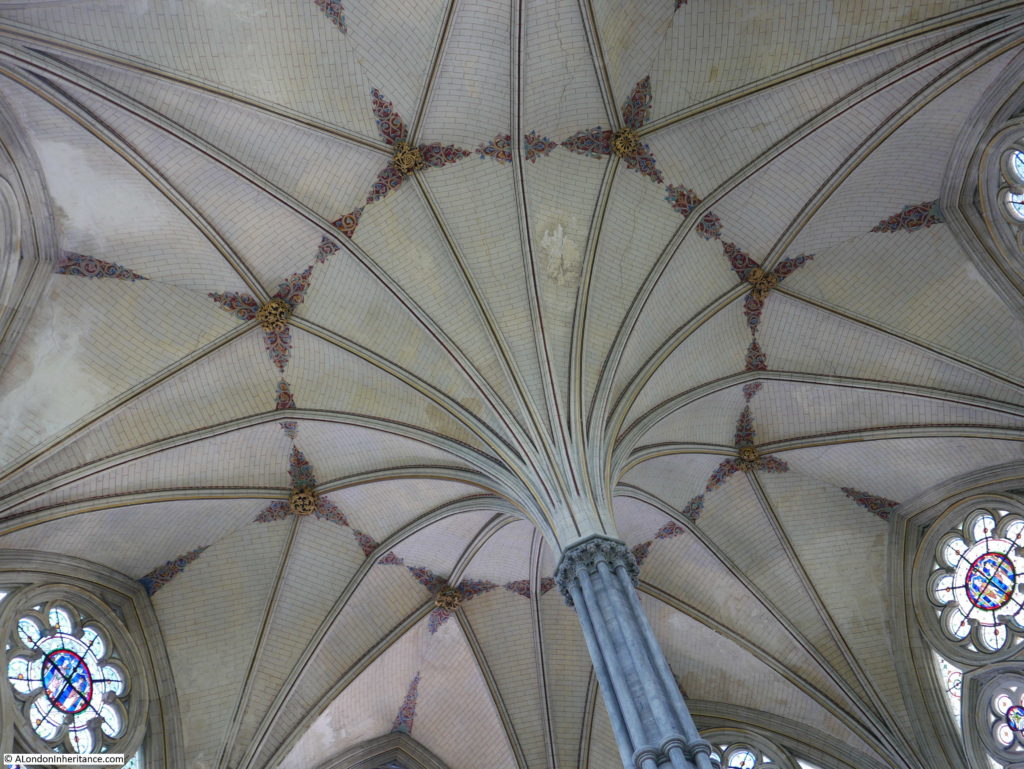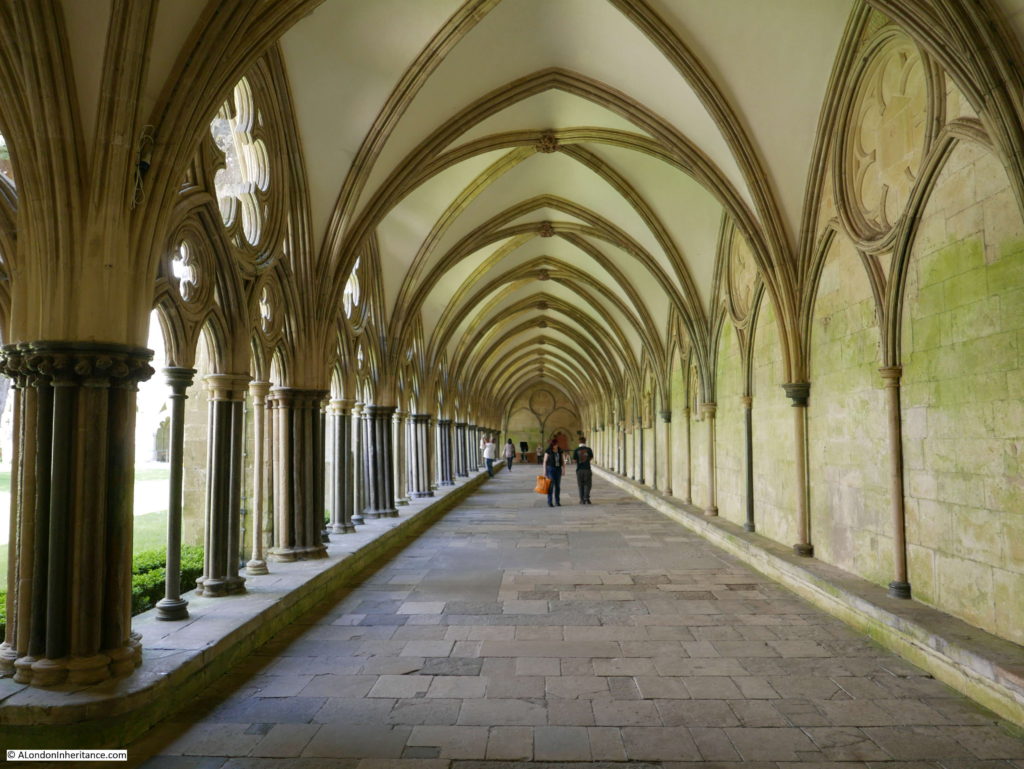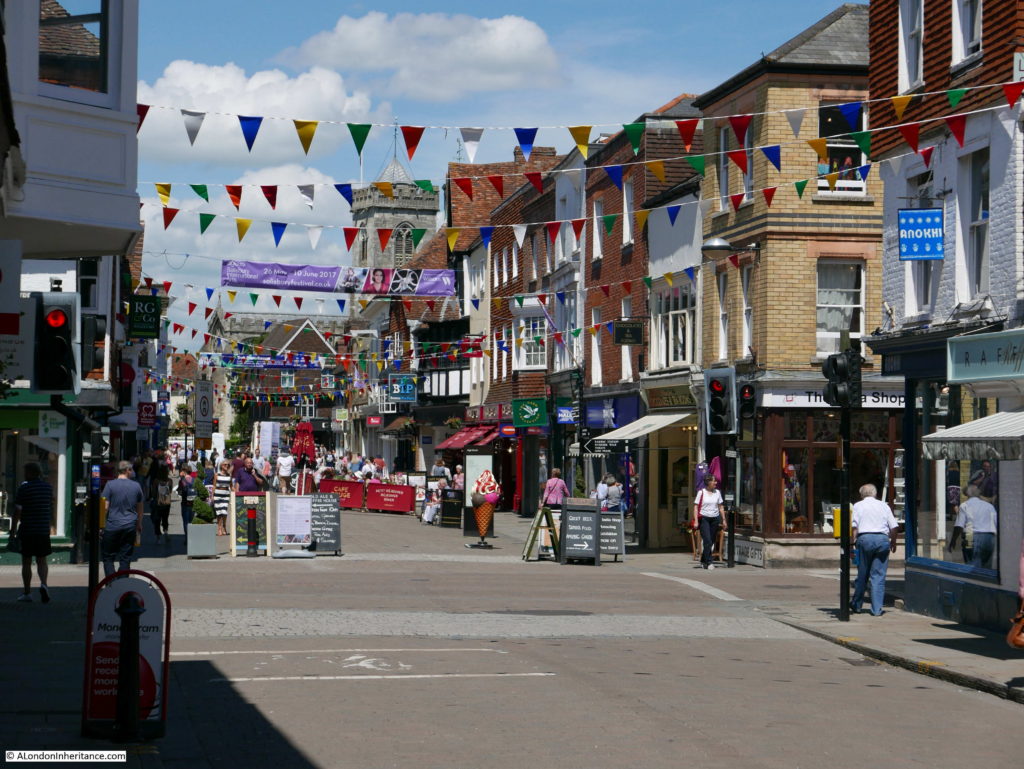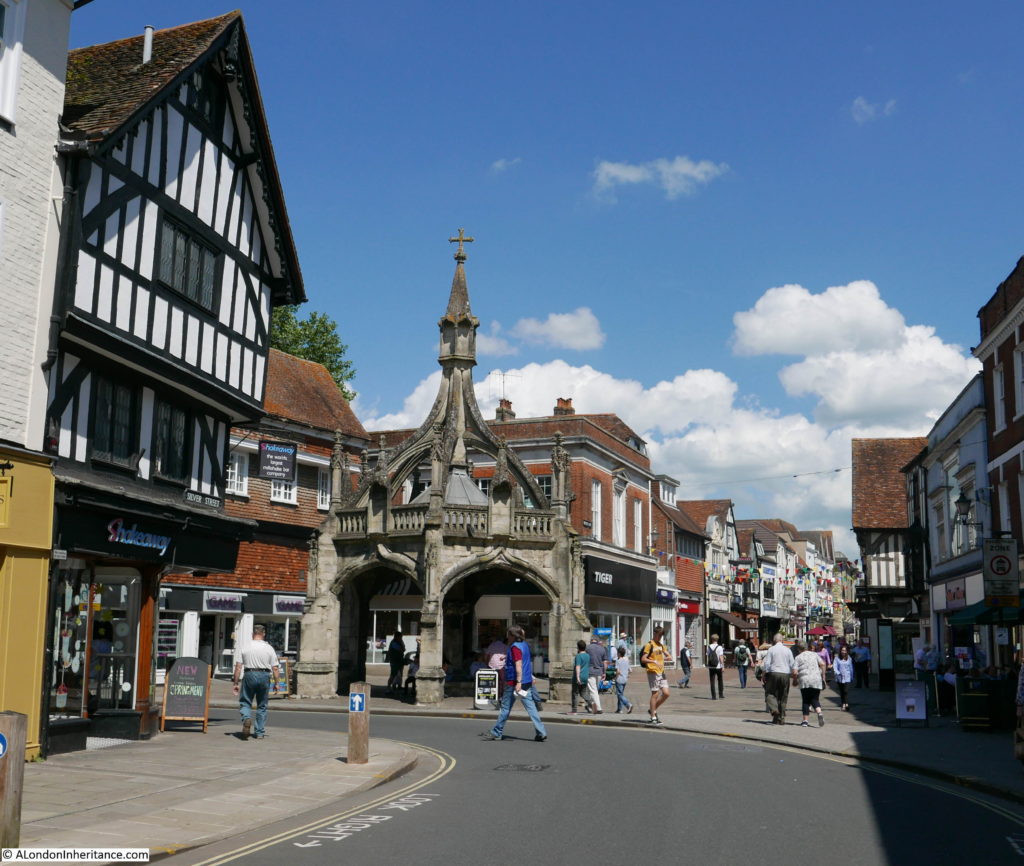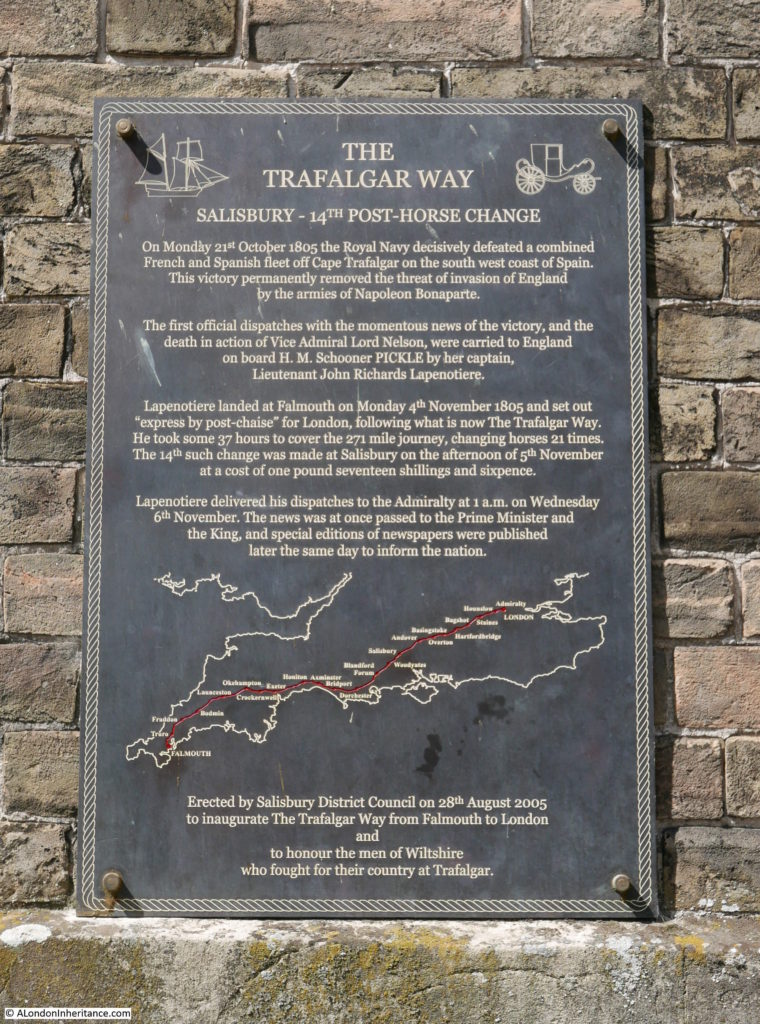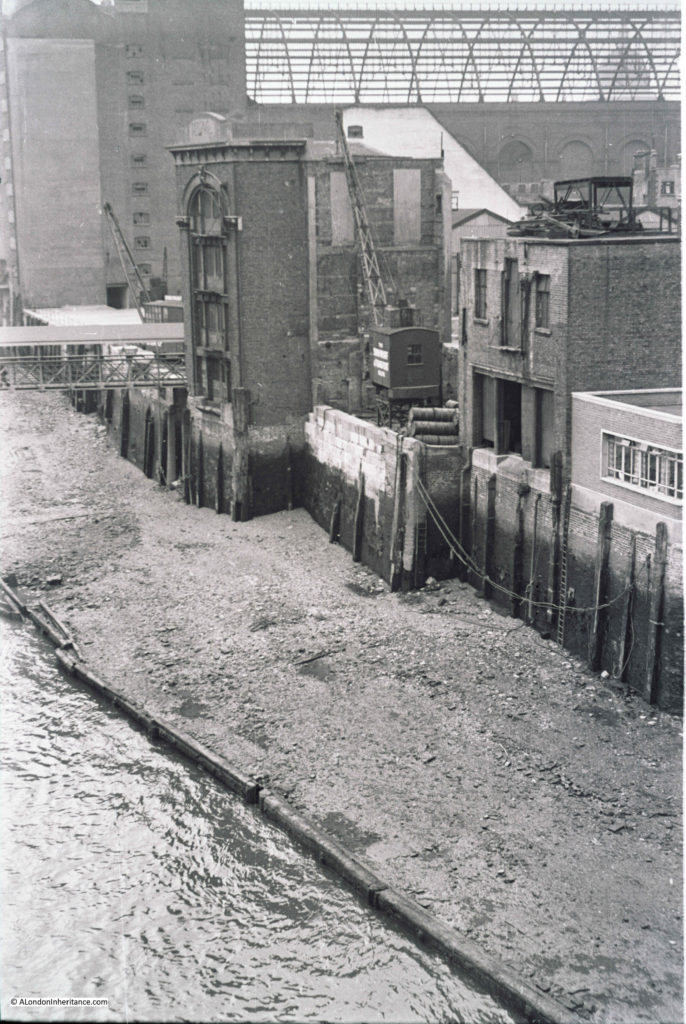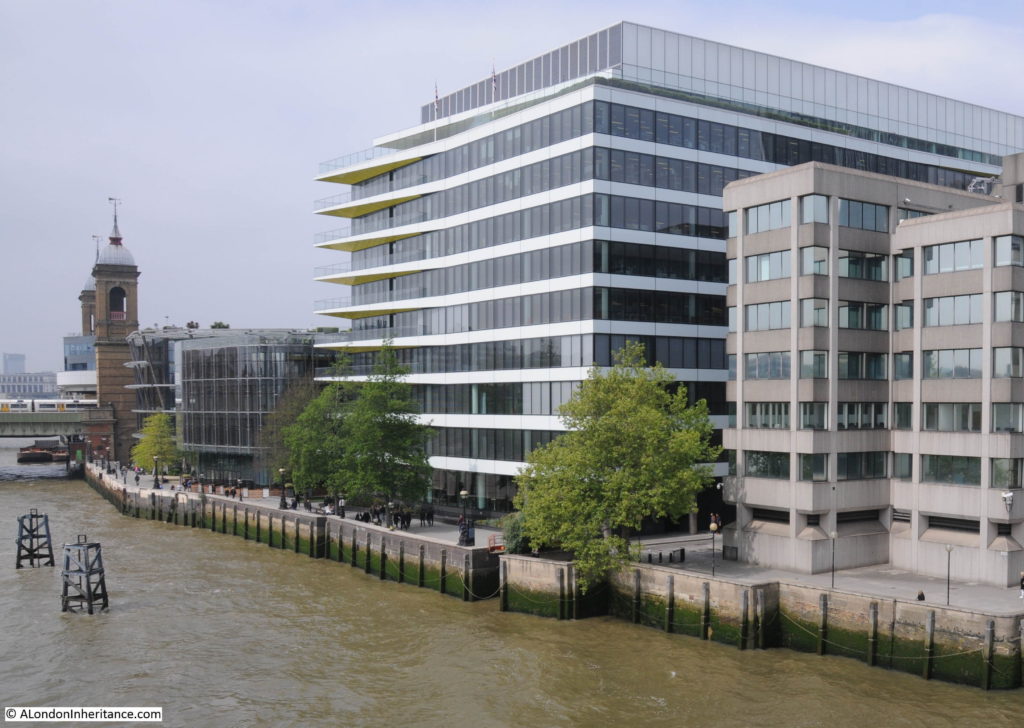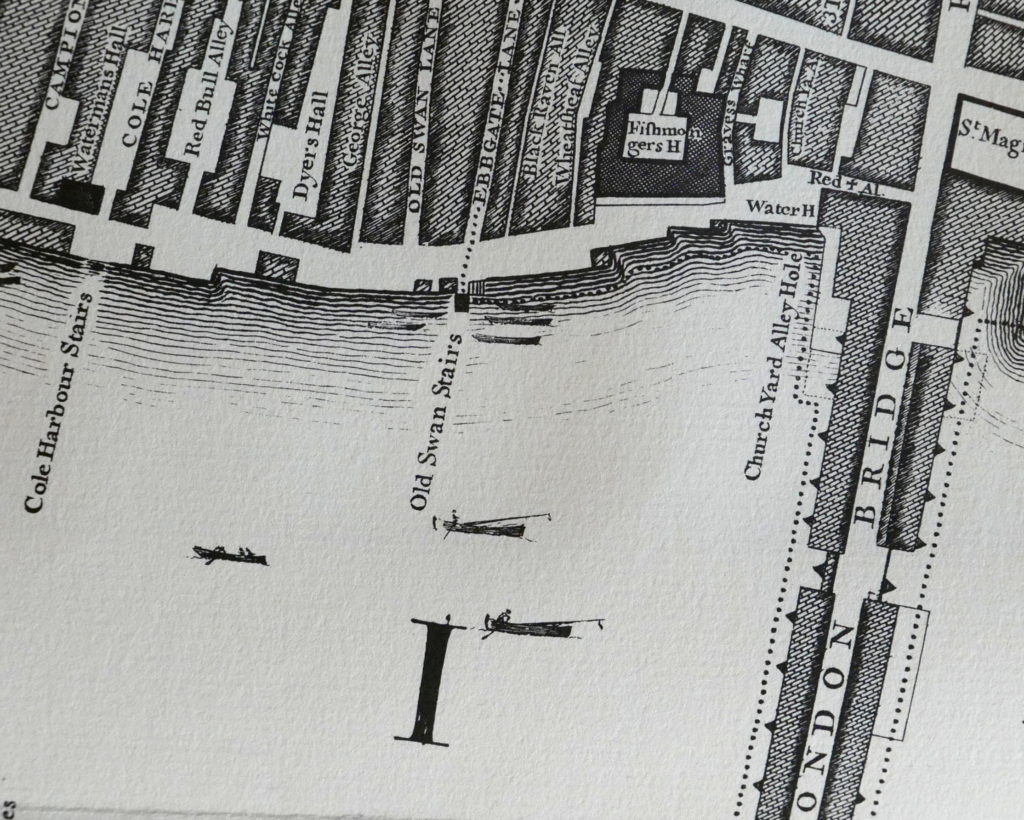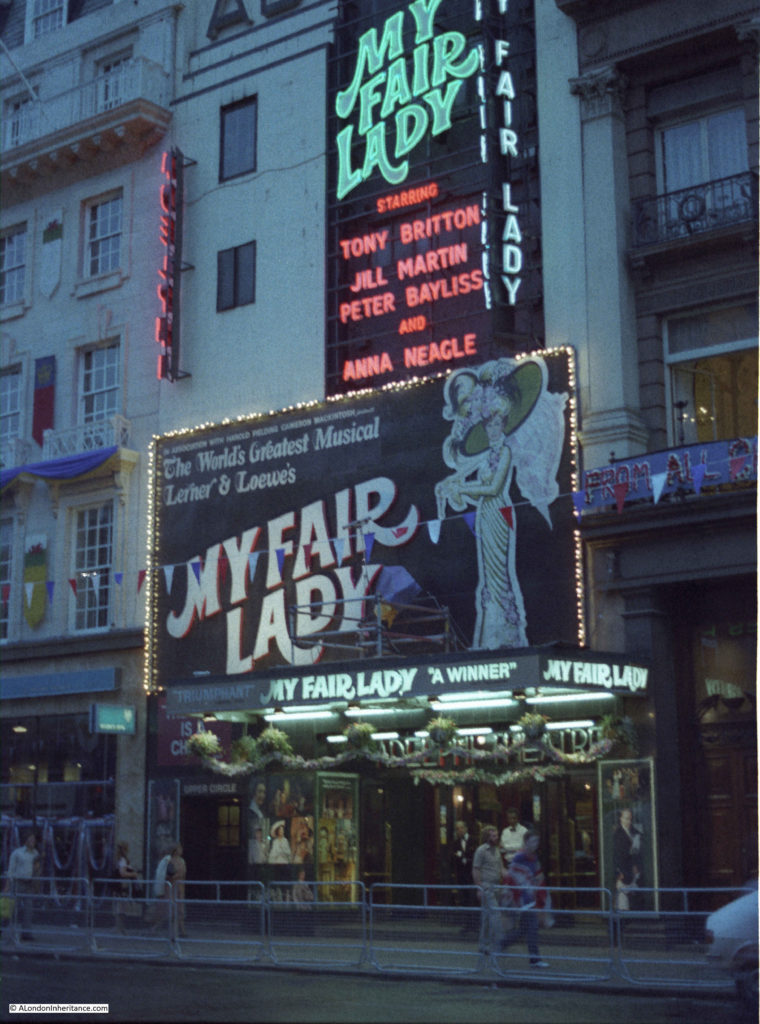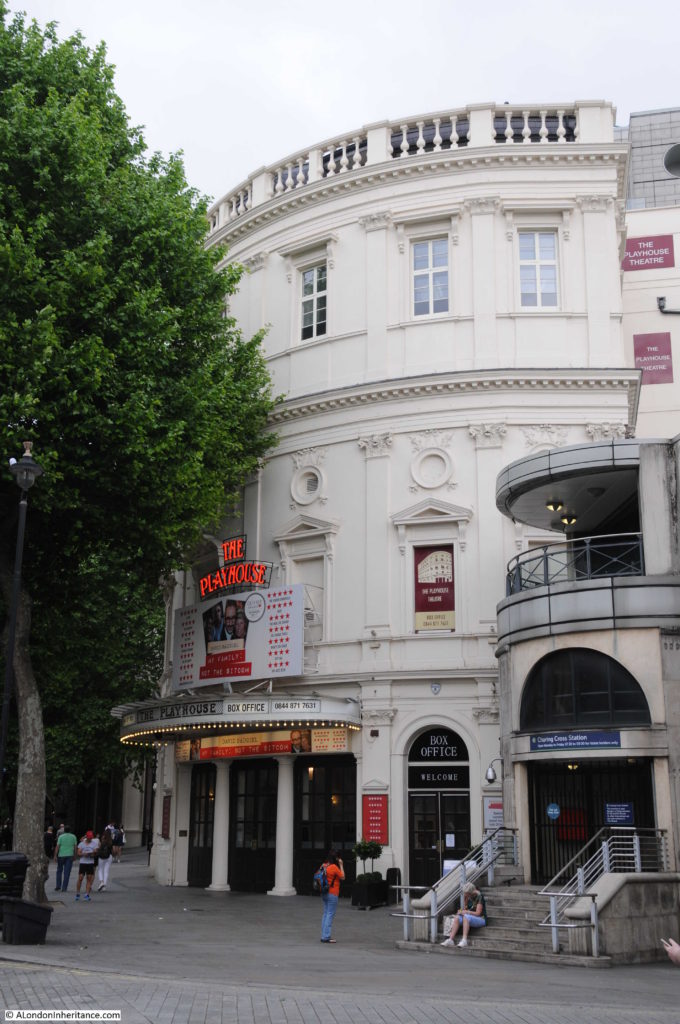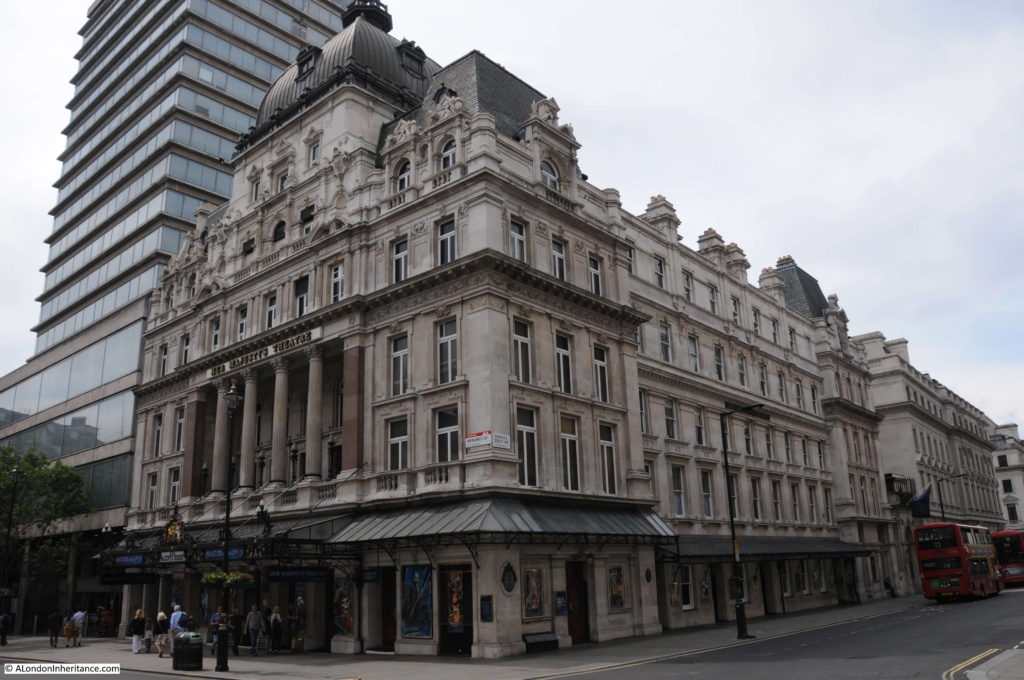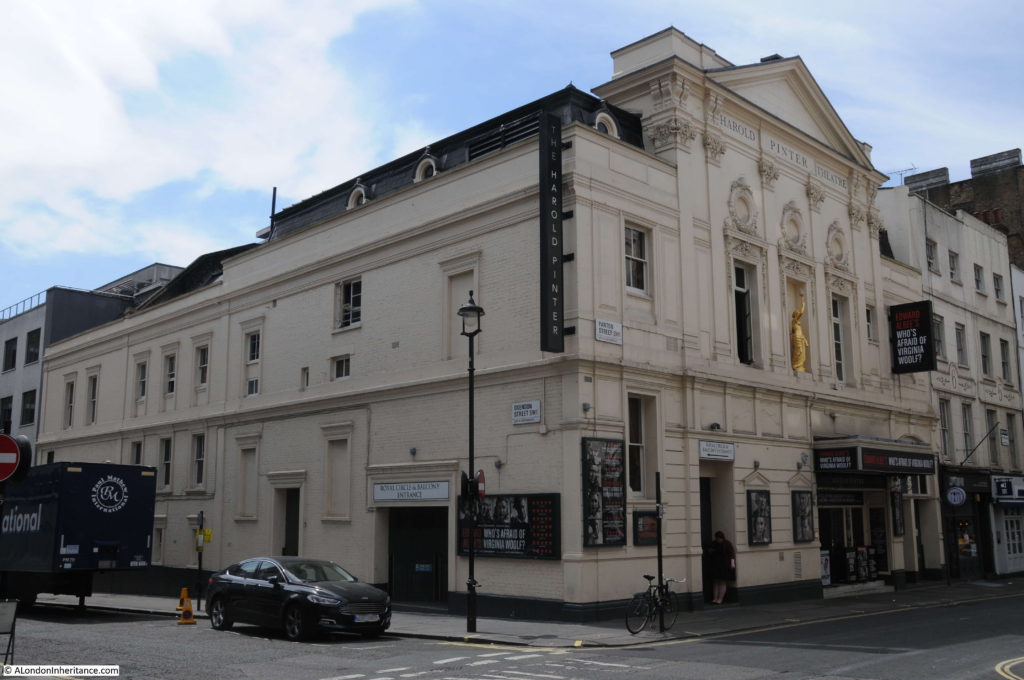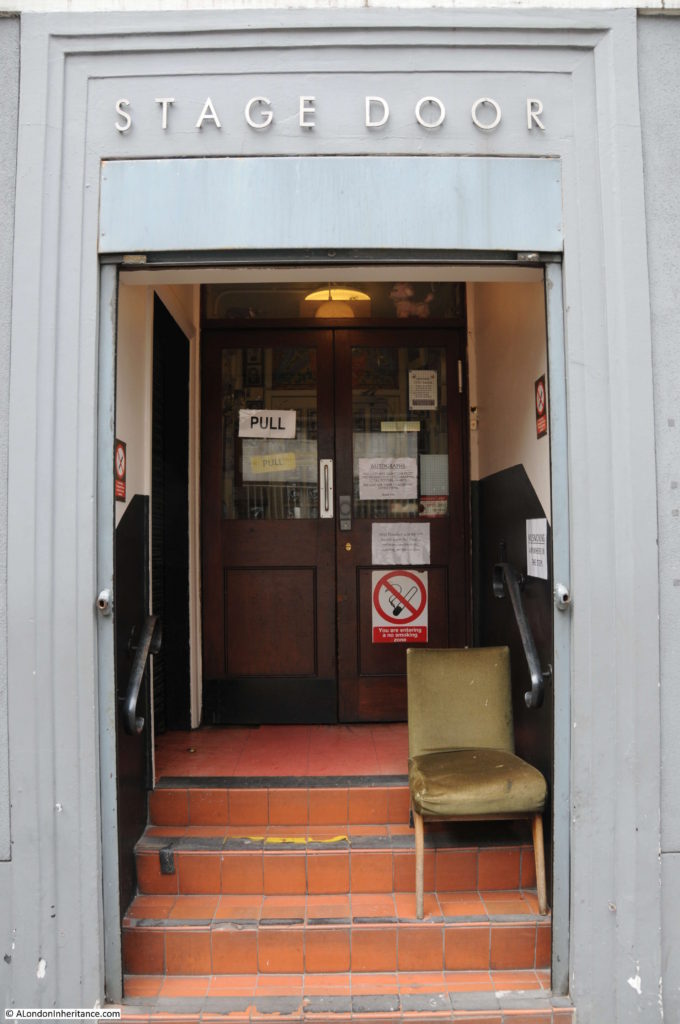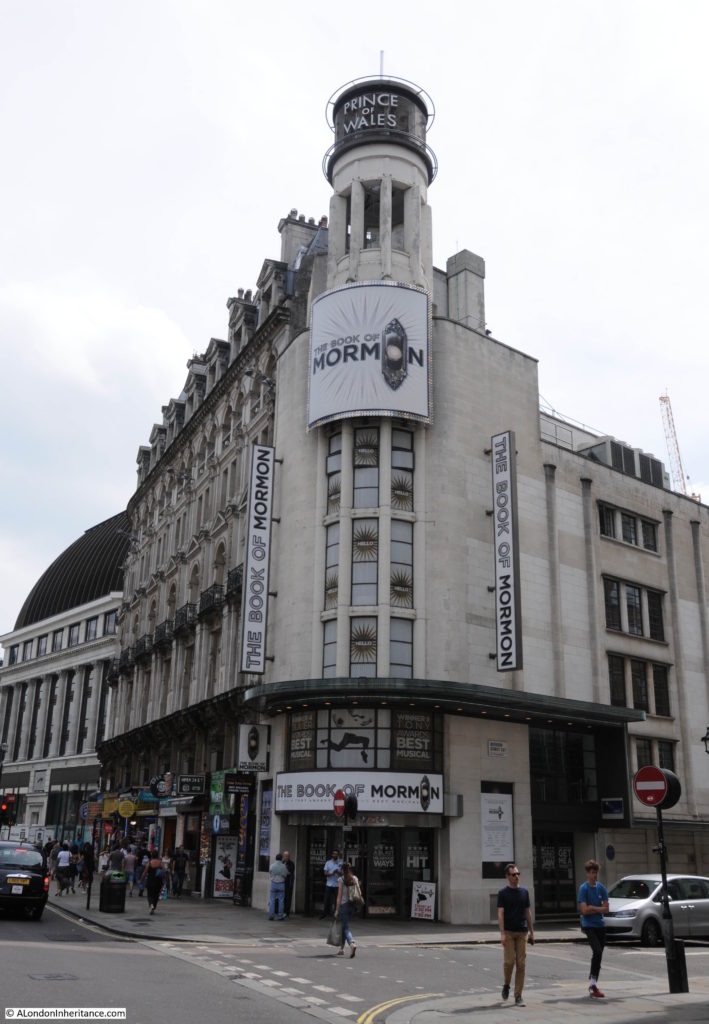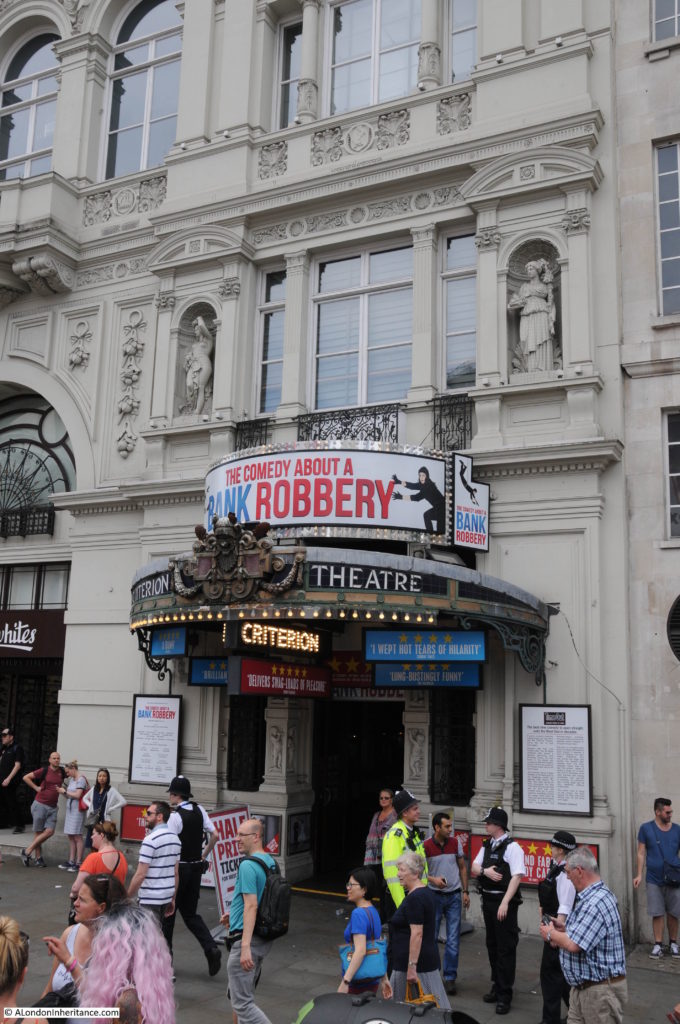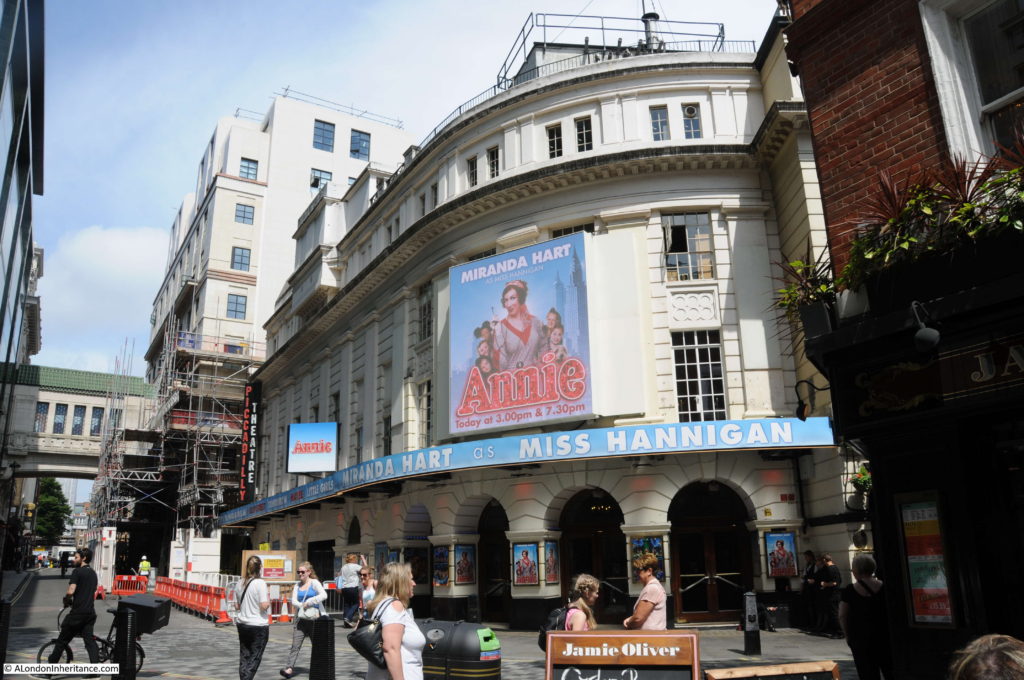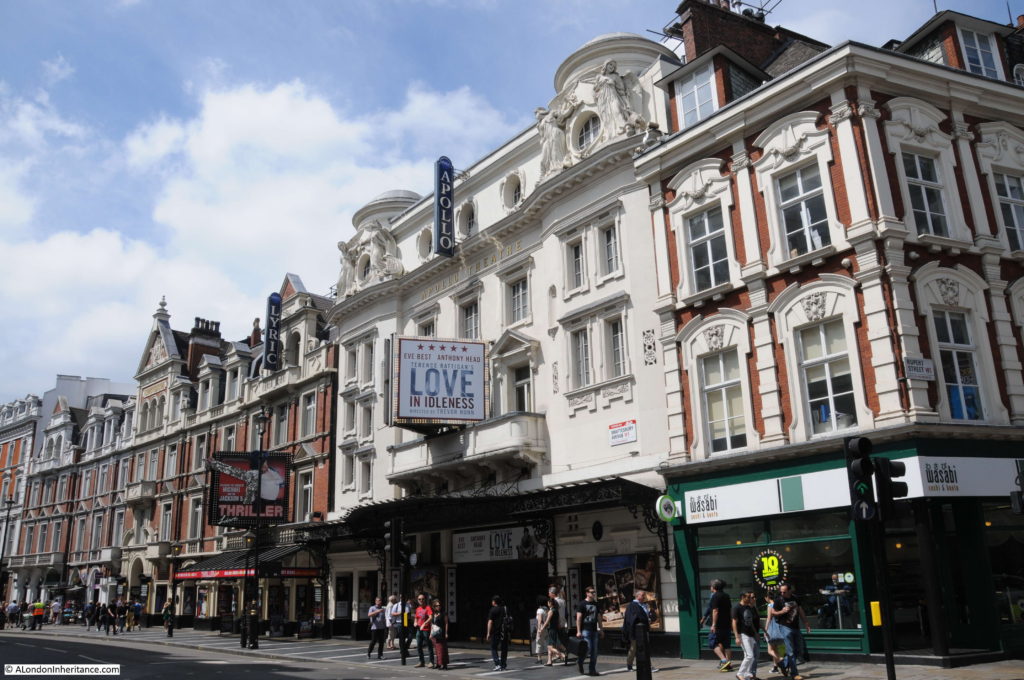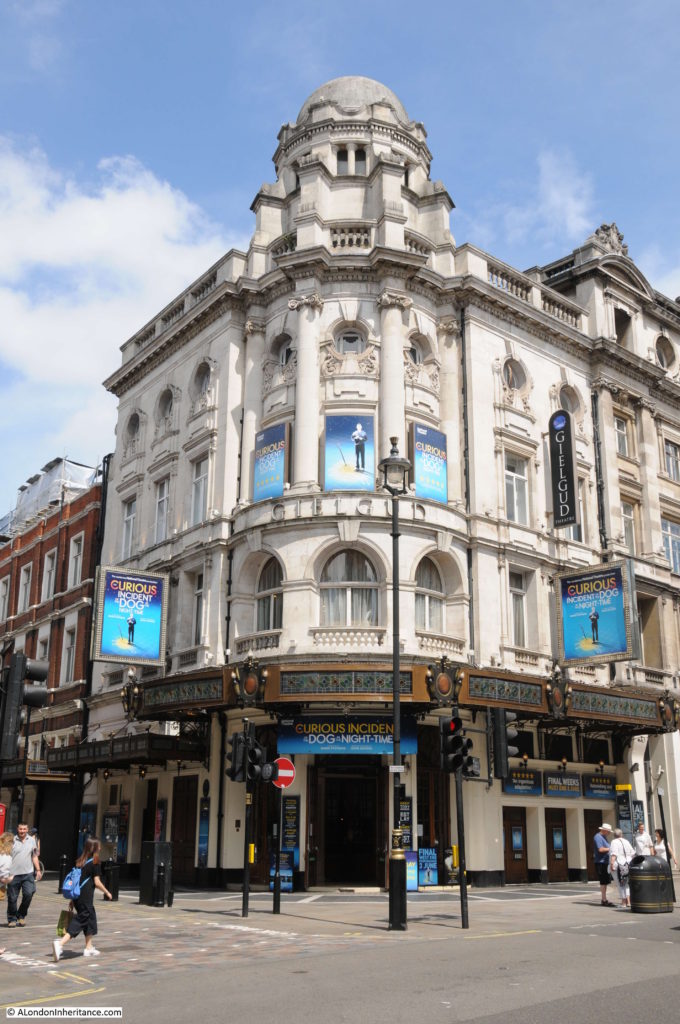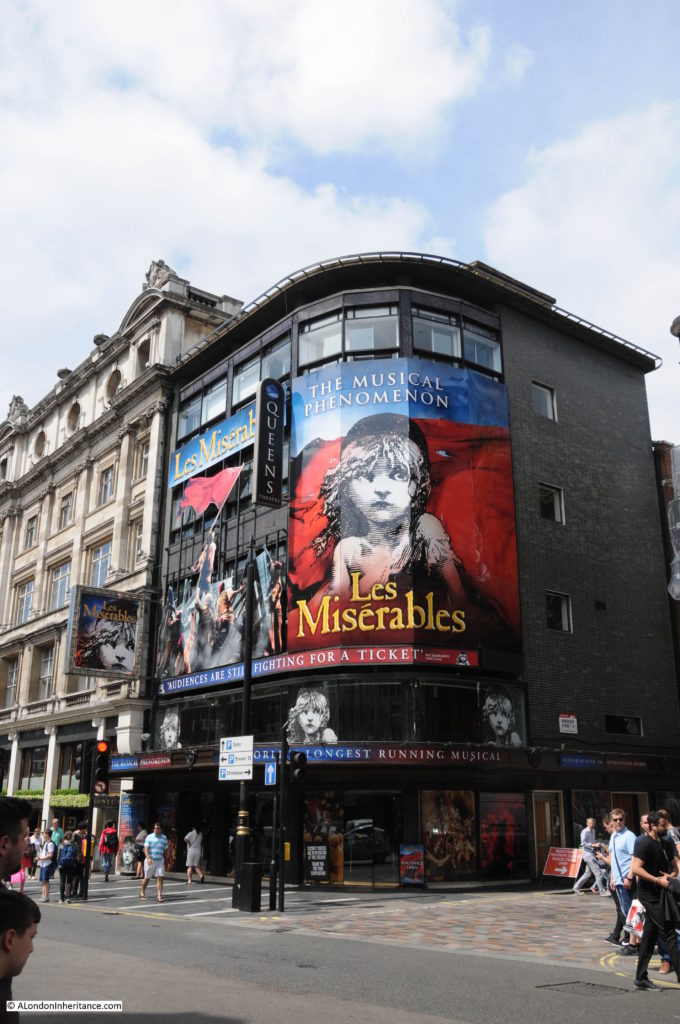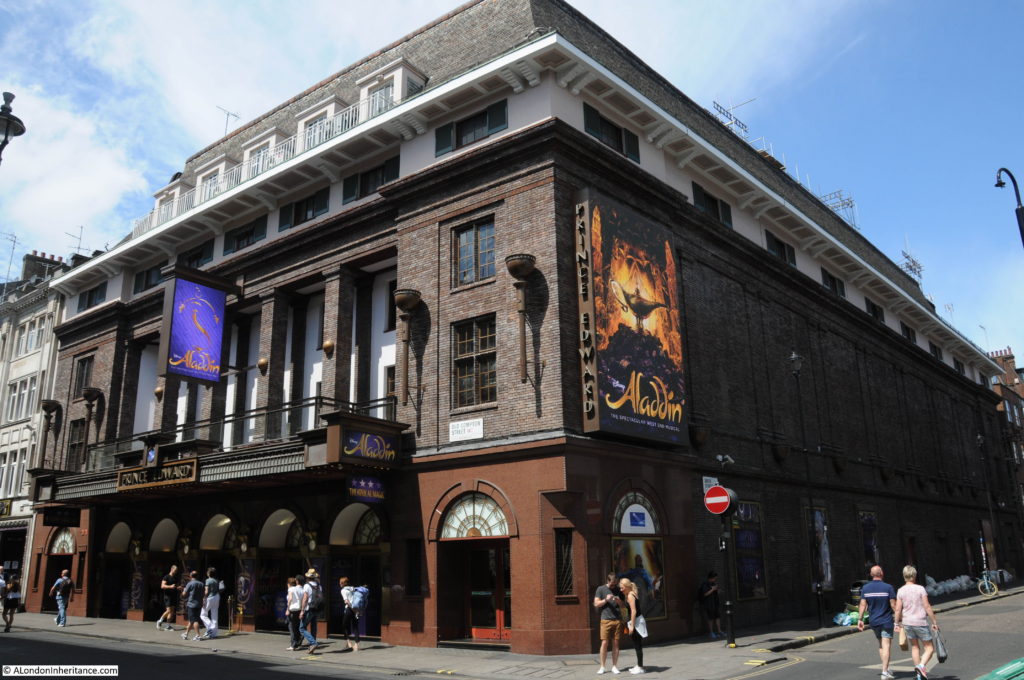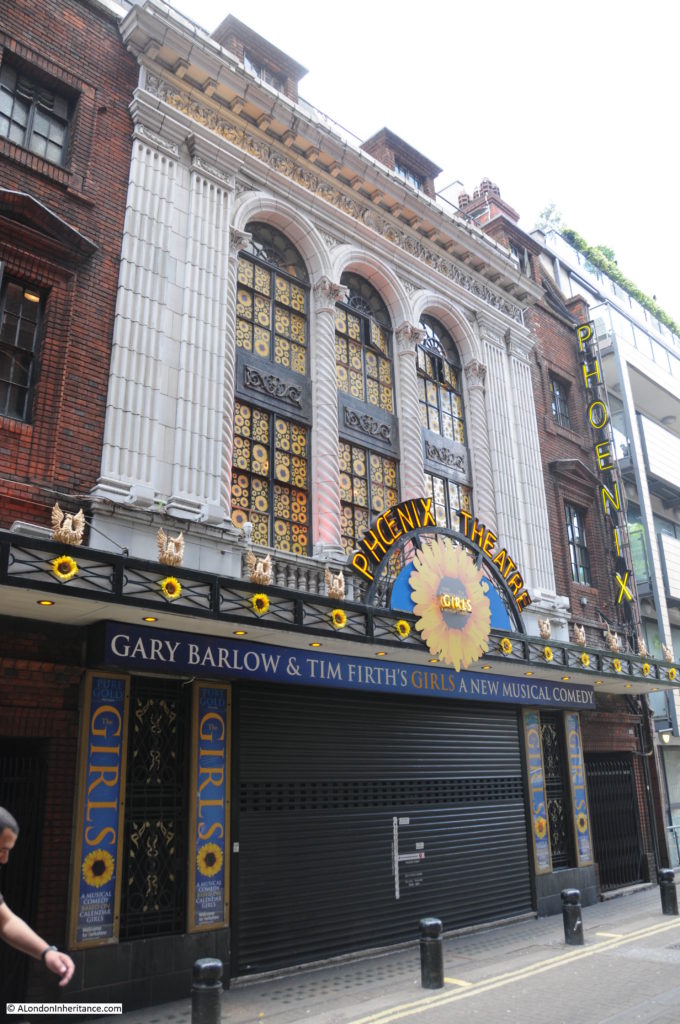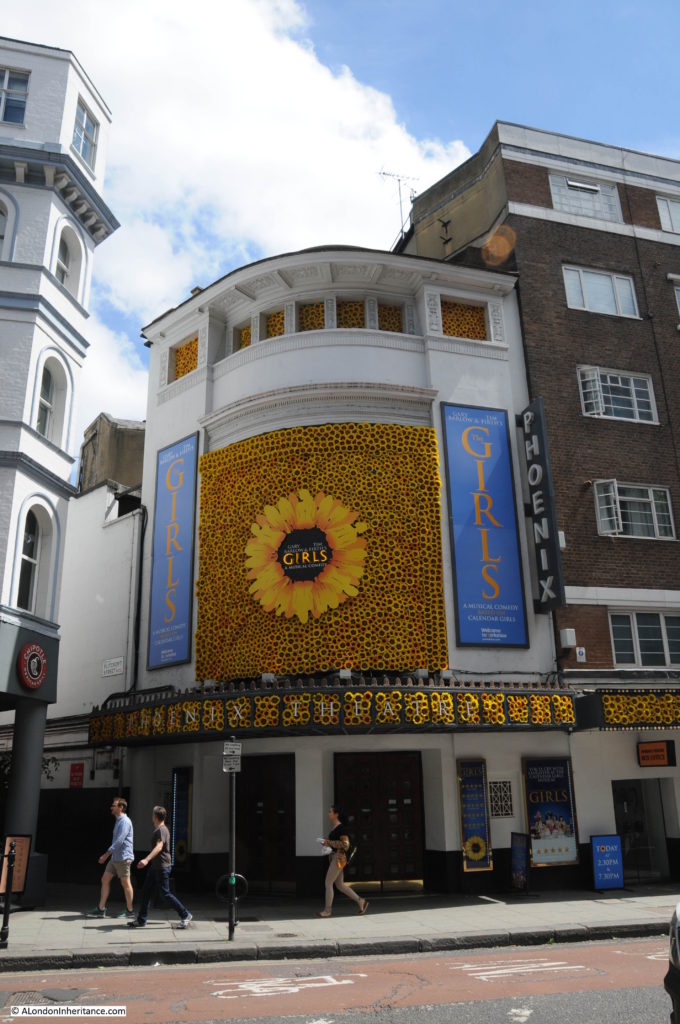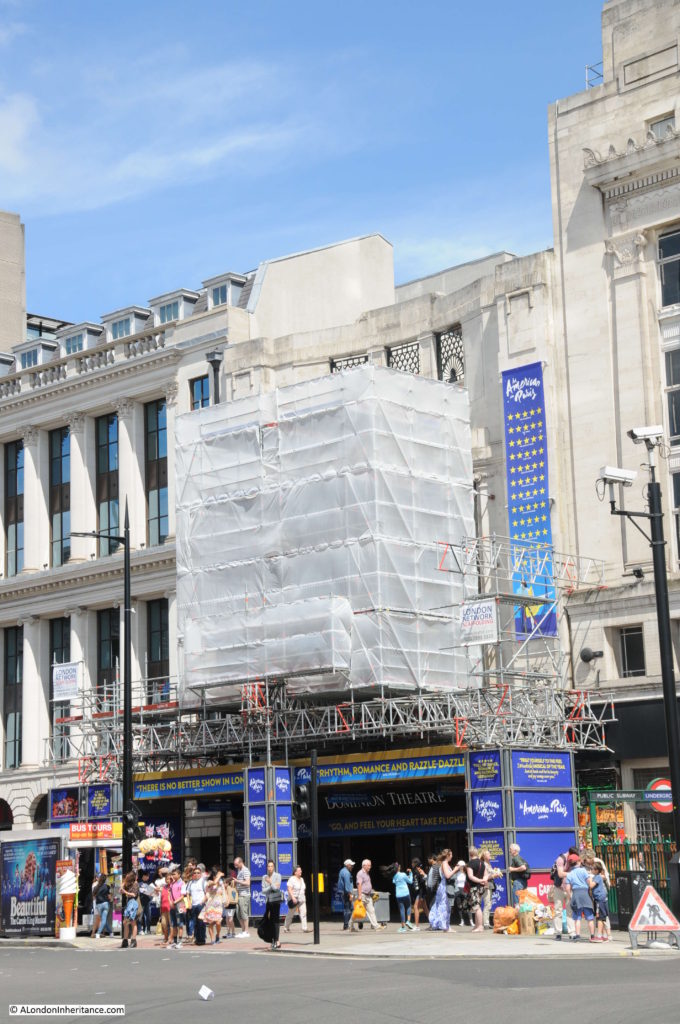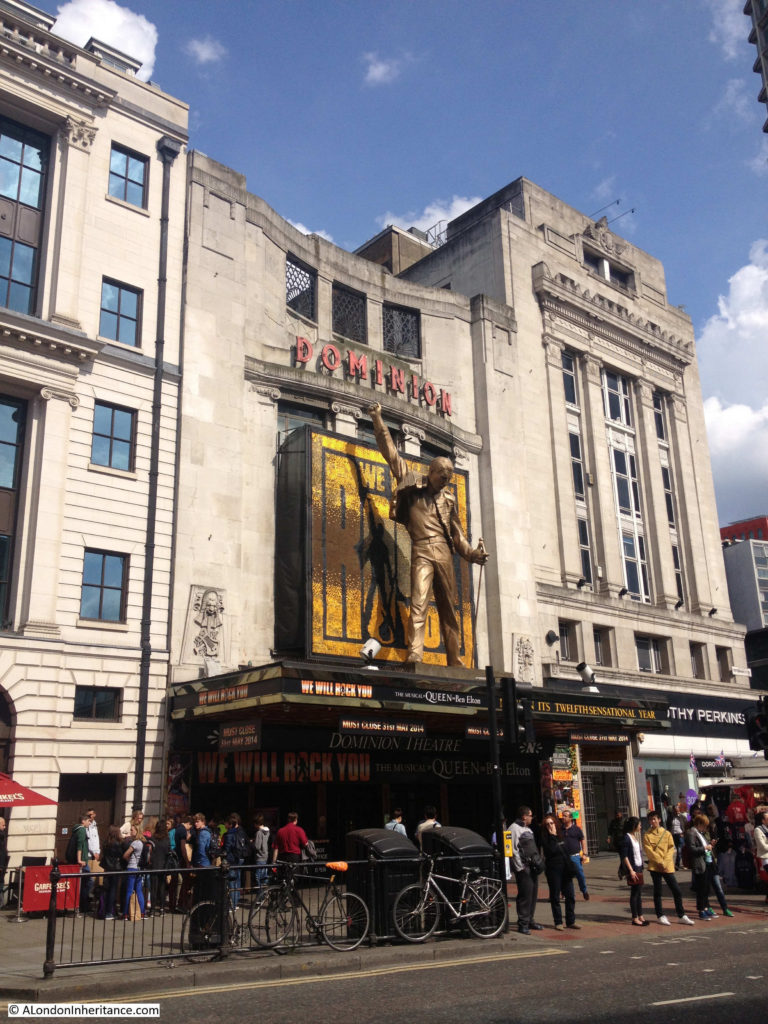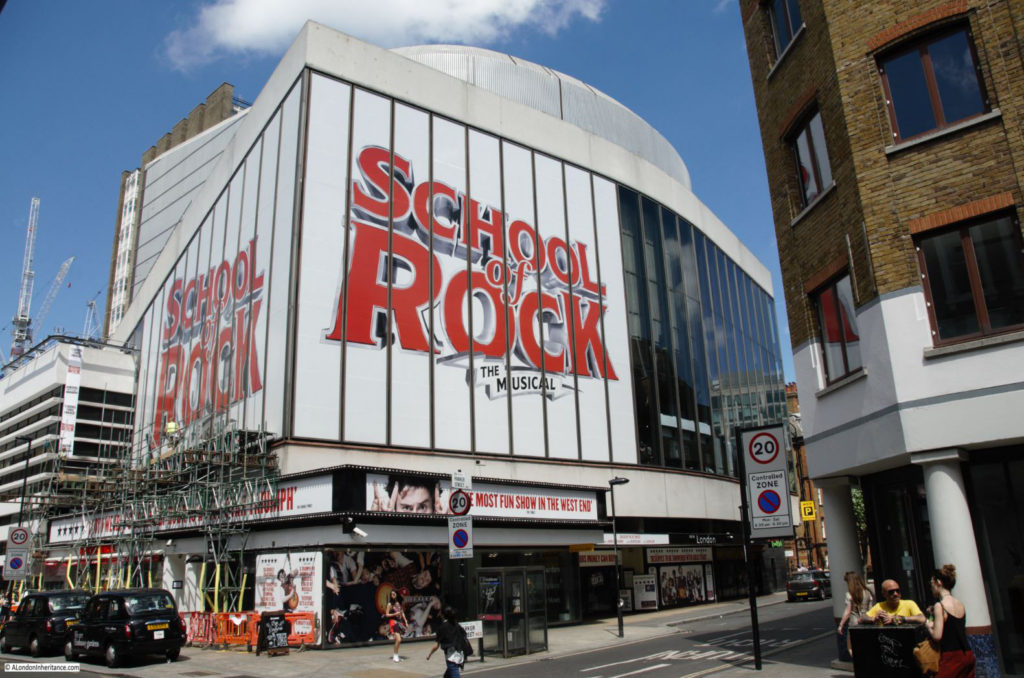A bit later than planned, however here is part two of my walk around the theatres of London’s West End on Saturday 27th May 2017. My earlier post covered the background and why I wanted to complete this walk and in part two I continue with my next theatre, the Donmar Warehouse, before walking to all the remaining theatres in the West End, finishing at the London Palladium.
The following interactive map shows all the theatres covered in my two posts:
Error: The map ID (2) does not exist
The Donmar Warehouse
After leaving the New London Theatre in Drury Lane, I then headed back to Seven Dials and in Earlham Street found the Donmar Warehouse: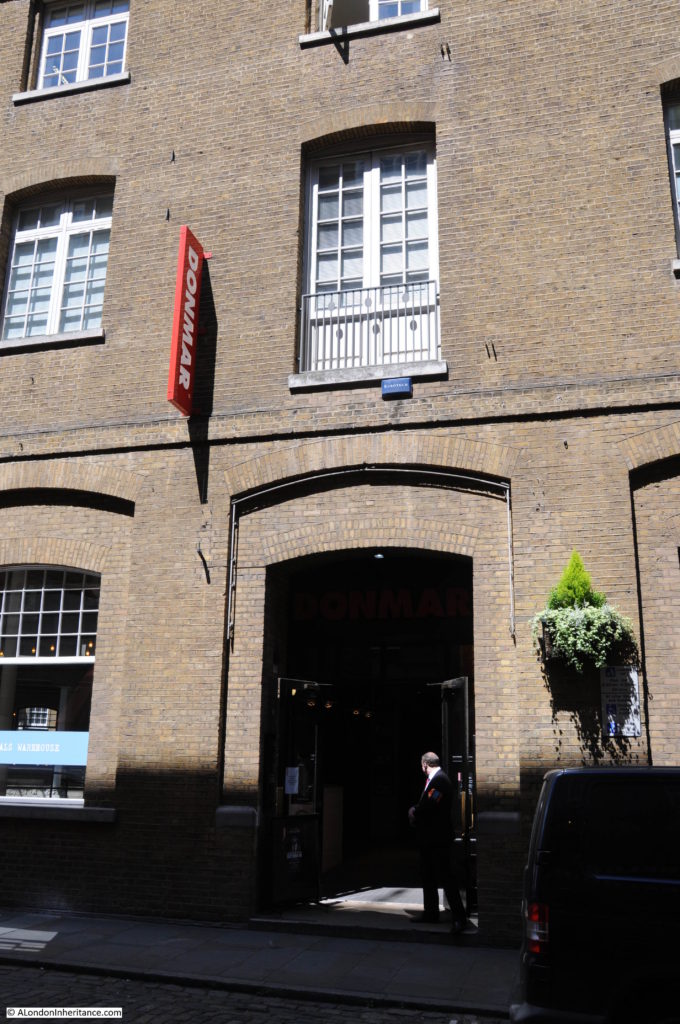
The Donmar Warehouse occupies a building that, as the name suggests, was a former warehouse providing storage for the nearby Covent Garden market.
Donmar is derived from the first three letters of Donald Albery’s first name (the theatre producer who purchased the building in 1961) and the first three letters of his wife’s middle name of Margaret.
Donald Albery’s son Ian converted the building into a rehearsal space.
In 1977 the building was purchased by the Royal Shakespeare Company who converted the space into a small theatre for workshops and productions open to the public.
In 1990 Roger Wingate acquired the building and two years later it reopened as the Donmar Warehouse.
It continues to operate as a small, independent theatre, one of the West End’s smallest with a seating capacity of 251.
The Donmar Warehouse was presenting The Resistable Rise of Arturo Ui
Cambridge Theatre
From the Donmar Warehouse it was a short walk along Earlham Street to find the Cambridge Theatre facing onto Seven Dials between Earlham Street and Mercer’s Walk:
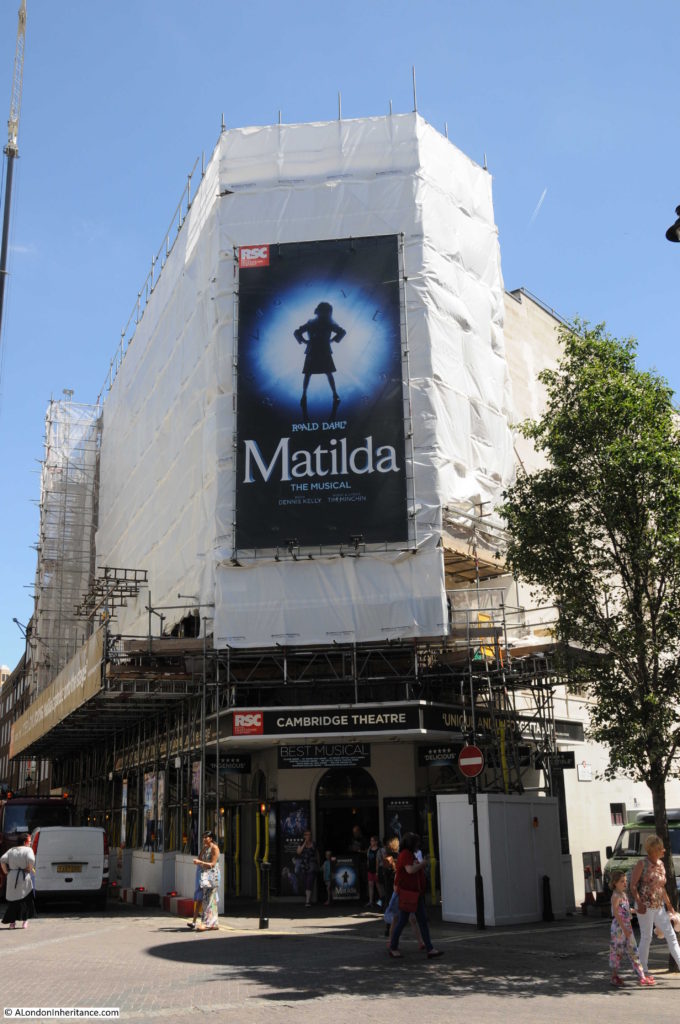
I am not sure what work is being carried out on the theatre building, but it was comprehensively covered scaffolding and sheeting.
The Cambridge Theatre is one of the relatively recent West End theatres having opened in 1930, since when it has hosted an almost continuous run of plays and musicals.
The Cambridge Theatre is currently showing Matilda by Roald Dahl
Tristan Bates Theatre
The Tristan Bates Theatre is very different to all the other theatres I have covered so far. The theatre is to be found in what appears to be an office block along Tower Street at the junction with Earlham Street: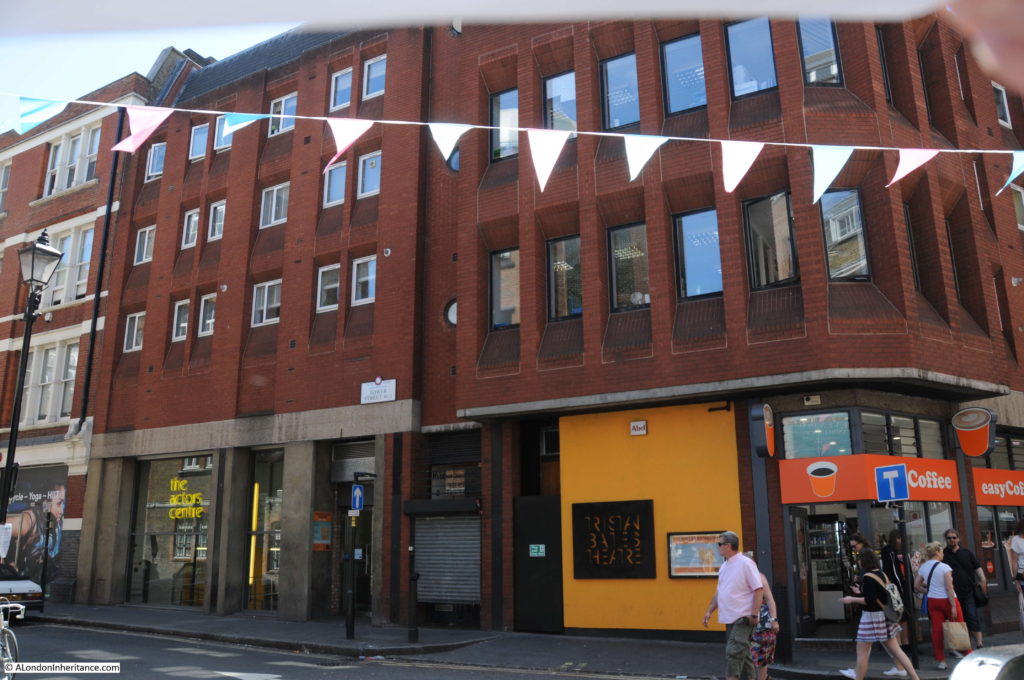
The Tristan Bates Theatre is part of the Actors Centre, an organisation set up in 1978 to support actors throughout their careers. The Actors Centre moved to the current location in 1994. At this time the actor Sir Alan Bates became a Patron and the Tristan Bates Theatre was set-up as part of the new location. The theatre is named after his son Tristan who had died at the age of 19 in 1990.
The Ambassadors Theatre
From the Tristan Bates Theatre I then walked along Shaftesbury Avenue and down West Street to find the Ambassadors Theatre: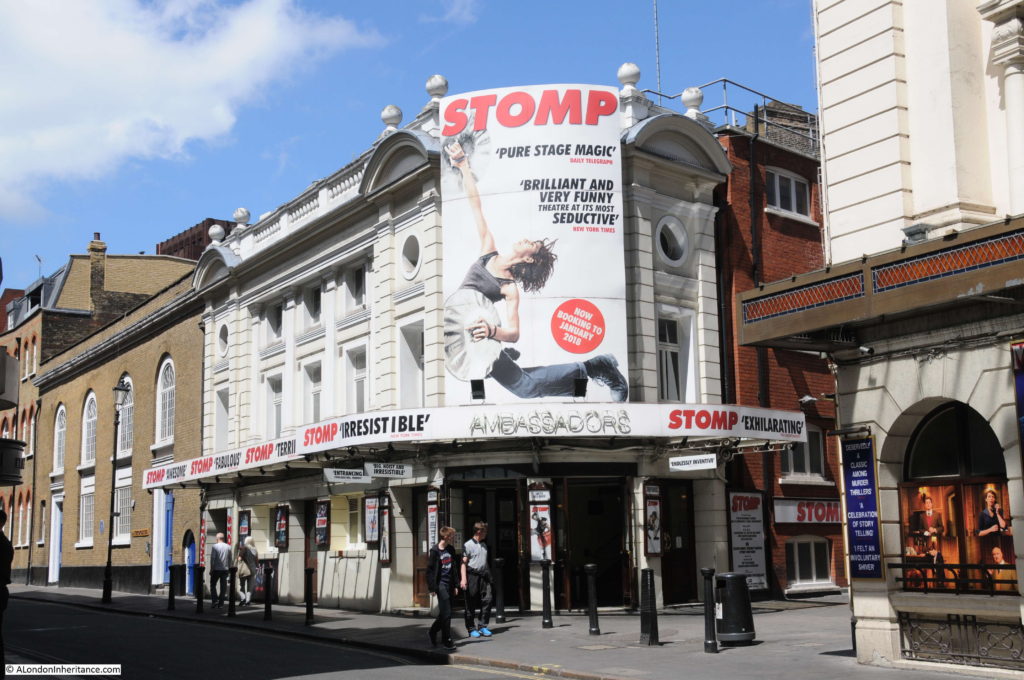
The Ambassadors Theatre was opened in June 1913 and has been run as a theatre since this time. The only period of change was for a short time during the late 1990s when the theatre was converted into two performance spaces allowing the Royal Court Theatre to be resident for three years. After the conversion back to a single performance space the theatre was renamed the New Ambassadors Theatre, but reverted back to the original name by dropping the “new” in 2007.
The St. Martin’s Theatre which is next door to the Ambassadors is best known for being the home of the long running play The Mousetrap, however The Mousetrap actually started its long run of performances at the Ambassadors Theatre, opening on the 25th November 1952 and continuing at the Ambassadors until 1973 when The Mousetrap moved to the theatre next door.
The Ambassadors Theatre is currently showing Stomp.
The St Martin’s Theatre
The St Martin’s Theatre is adjacent to the Ambassadors Theatre, separated by the alley way of Tower Court:
The St. Martin’s Theatre was designed by W.G.R. Sprague who was also responsible for the design of the Ambassadors, although St Martin’s opened three years later in 1916 with construction having been delayed by the start of the 1st World War.
The St. Martin’s Theatre is best known for the long running play by Agatha Christie, The Mousetrap and a plaque on the theatre commemorates the 50th anniversary performance in 2002, however the plaque is possibly not quite clear as for almost the first half of these 50 years The Mousetrap was playing at the adjacent theatre.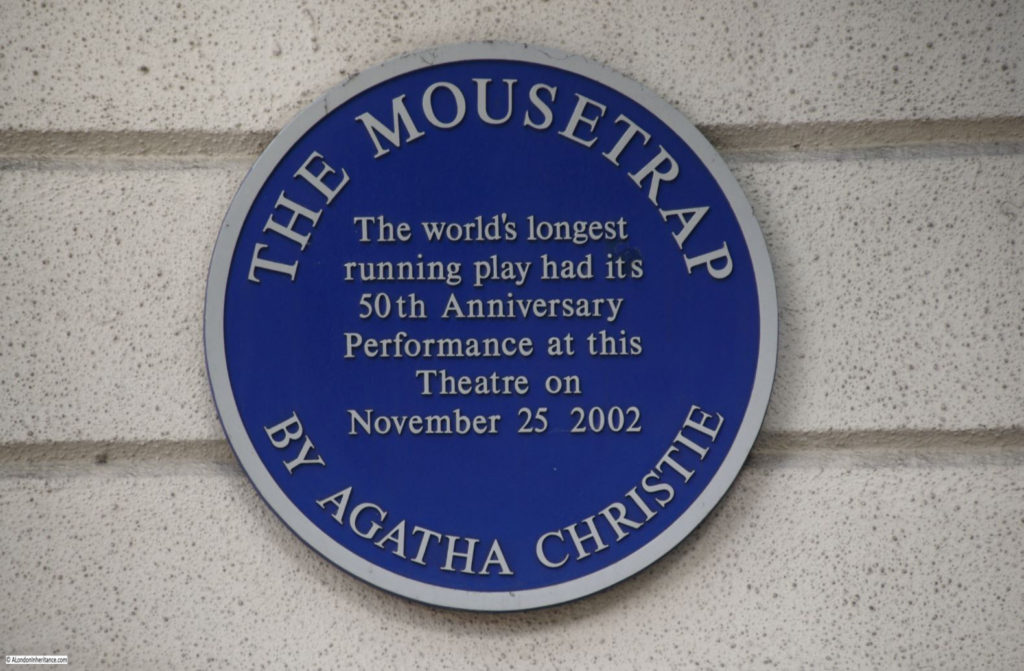
The Arts Theatre
A walk down Upper St. Martin’s Lane took me to Great Newport Street and the Arts Theatre:
The Arts Theatre was opened in 1927 as a private members club. This enabled the theatre to bypass censorship by the Lord Chamberlain.
The Arts Theatre is one of the smaller West End theatres with a maximum capacity of 350.
The Arts Theatre is currently showing Judy!
Wyndham’s Theatre
From Great Newport Street then down Charing Cross Road to the Leicester Square Underground Station where I found Wyndham’s Theatre:
Wyndham’s Theatre opened in 1899 and is named after the original owner of the theatre, the actor – manager Charles Wyndham. It was designed by the prolific theatre designer W.G.R. Sprague, who as well as being responsible for St. Martin’s and the Ambassadors which I have covered above, also designed the Noel Coward Theatre, the Aldwych, Novello, Gielgud and Queen’s Theatres.
Although hard to see due to the large tree that is covering part of the theatre facade, it has a lovely symmetrical design. The original design for the theatre included a winter garden on the roof space, however council approval for this feature was not granted so what would have been a rather unique feature for a West End Theatre did not get built.
Wyndham’s Theatre is currently showing Don Juan in Soho
Leicester Square Theatre
The Leicester Square Theatre is not in Leicester Square, but can be found up the side street of Leicester Place: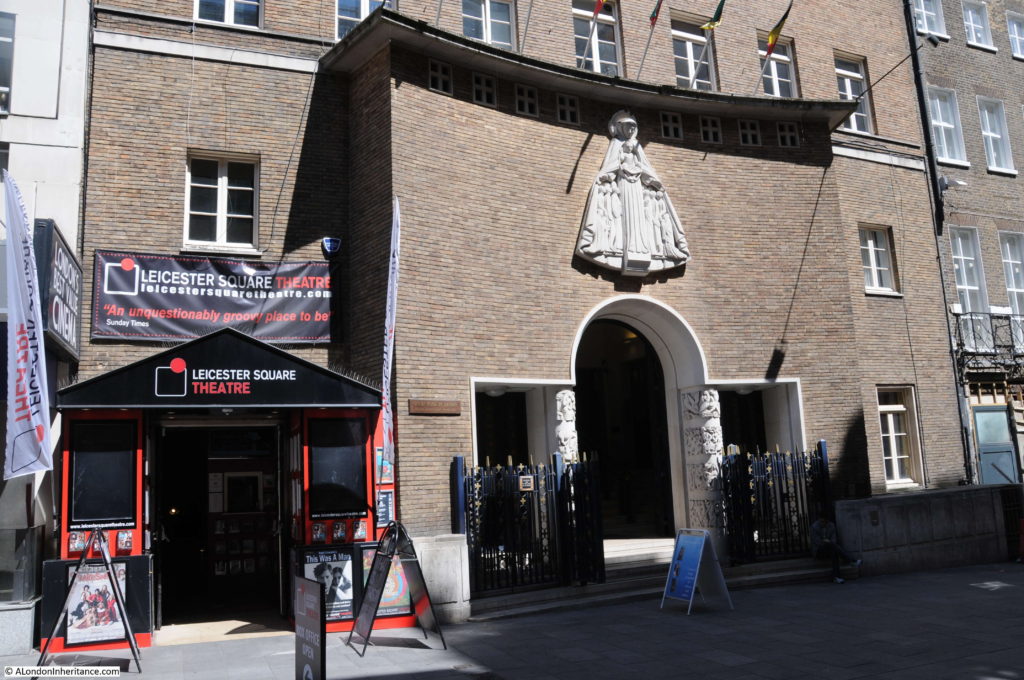
The Leicester Square Theatre is rather unusual as the theatre entrance is part of the church of Notre Dame de France.
The church is a French Catholic church consecrated in 1868 to serve the large French community of the area. The church was damaged badly during the war and went through a number of restorations and rebuilds with the main rebuilding being completed between 1953 and 1955.
The area occupied by the Leicester Square Theatre was used as a French cultural centre after the rebuild, but changed use in the 1960s to become a music venue hosting bands such as the Rolling Stones and the Who and in 1979 it was the location for the first performance of “London Calling” by the Clash – an album that seemed to perfectly sum up the final years of the 1970s.
It opened as the Leicester Square Theatre in 2008 and hosts a wide variety of performances including music and comedy.
Noel Coward Theatre
Back to Charing Cross Road, cross over to walk along St. Martin’s Court to reach St. Martin’s Lane and the Noel Coward Theatre:
The Noel Coward Theatre has been through a couple of name changes since it opened in 1903 as the New Theatre. The first production at the New Theatre was “Rosemary” in which Charles Wyndham (the original owner of Wyndham’s Theatre) and his future wife Mary Moore starred.
in 1920 Noel Coward made his debut here, but it would be several decades before the theatre took his name. In 1973 the theatre changed name from the New to the Albery after the son of Mary Moore, Bronson Albery who was a long standing manager of the theatre. Bronson was born during Mary’s earlier marriage to the dramatist James Albery who had died in 1889.
West End theatre in the couple of decades before and after 1900 seems to have been a very close knit community with the same names coming up for theatre design, theatre owners, actors and managers.
The theatre finally changed name to the Noel Coward Theatre on the 1st June 2006, so it has only had this name for a relatively short 11 years in the 114 year history of the theatre.
The Noel Coward Theatre is currently showing Half A Sixpence.
The Duke of York’s Theatre
Also in St Martin’s Lane is the Duke of York’s Theatre: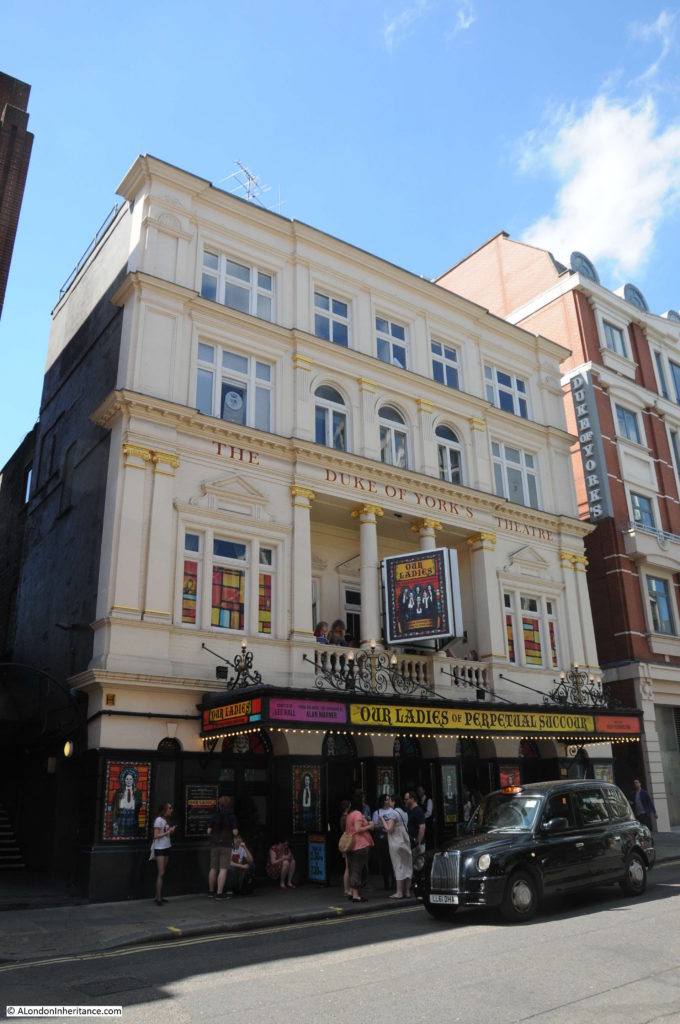
The theatre opened in 1892 and was known for a very short period as the Trafalgar Square Theatre, before changing name in 1895 to the Duke of York’s Theatre for the future king, George V.
West End Theatres have been through many different types of ownership over the decades, with many theatres originally owned by individuals, often directly involved either as actors or managers. Today, the majority of theatres are owned by organisations, for example the Duke of York’s is today owned by the Ambassador Theatre Group who also own in London the Apollo Victoria, Duke of York’s, Fortune, Harold Pinter, Lyceum, Phoenix, Piccadilly, Playhouse, Savoy and Trafalgar Studios.
The Duke of York’s Theatre is unusual in that it is the only West End theatre I have found that was once owned by a radio station. From 1979 until 1992 the theatre was owned by Capital Radio.
Today, the Duke of York’s Theatre is showing Our Ladies of Perpetual Succour.
The London Coliseum
At the southern end of St Martin’s Lane is the London Coliseum: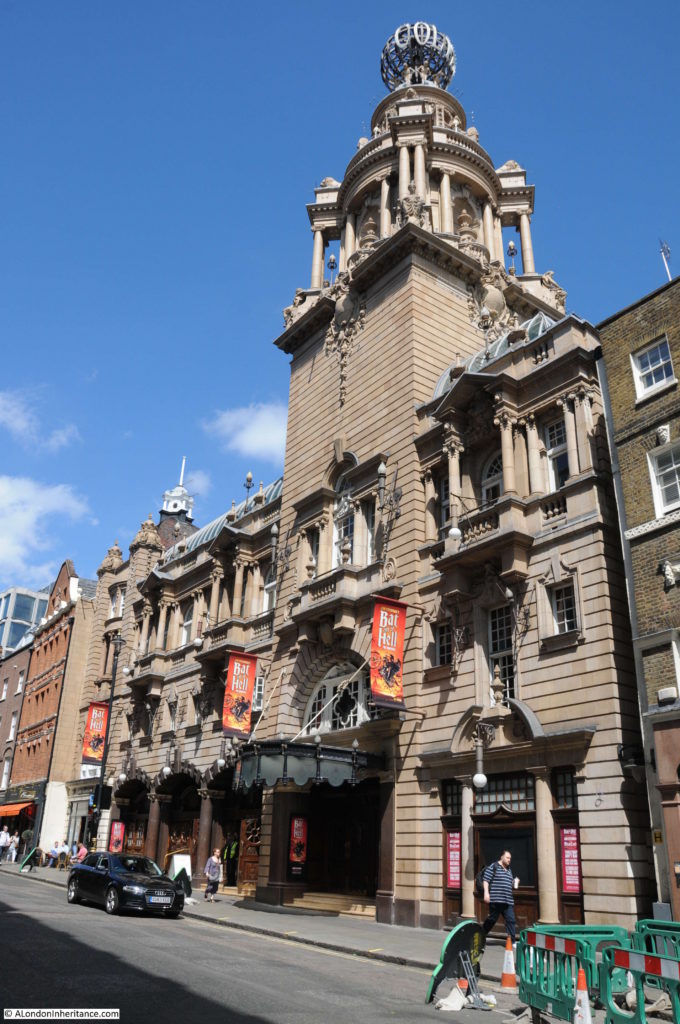
The London Coliseum is perhaps better known as the home of the English National Opera and English National Ballet rather than as a traditional West End theatre, however this was not always so, and the London Coliseum has, and continues to be home to a broad range of productions.
Opened in 1904 as the London Coliseum Theatre of Varieties, the theatre was more in the tradition of music hall and variety acts and at the time held the record for the largest theatre in London with around 2,500 seats.
As with many other West End theatres, the London Coliseum has been through some changes since it opened. It has put on plays, musicals, comedies and pantomimes and for short periods has been used as a cinema.
The name has changed relatively little with “London” being dropped from the name between 1931 and 1968.
The theatre has been the West End home of the Sadler’s Wells Opera Company since 1968 when the company relocated to the London Coliseum, changing their name to the English National Opera in 1974.
The large tower above the theatre dominates the surrounding area. I assume the large globe with the name Coliseum on the top of the tower still rotates – one of those features you take for granted.
The advertising on the facade of the London Coliseum is for the June opening of the musical Bat Out Of Hell.
Garrick Theatre
From the London Coliseum I took a short walk back up Charing Cross Road to the Garrick Theatre: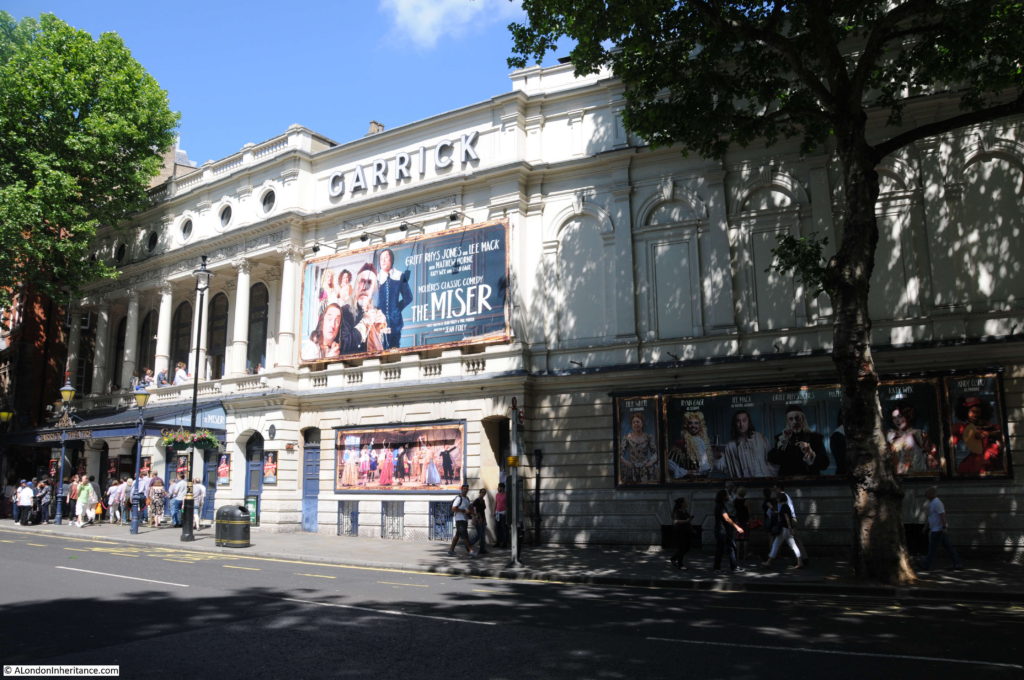
The Garrick Theatre was opened in 1889 (it really is remarkable how many West End theatres were opened in the years around 1900 – the West End must have been a hive of theatrical activity around the turn of the century).
The theatre was named after the 18th century actor David Garrick and as far as I can tell, it has not changed name in the 128 years since the theatre opened. The Garrick Theatre has put on an almost continuous run of plays, musicals and comedies since opening.
The Garrick is currently showing The Miser.
The Adelphi
It was now time to leave the cluster of theatres around Charing Cross Road and St Martin’s Lane and head to the next cluster of theatres in Aldwych via the Strand. The first theatre in the Strand is the Adelphi:
There has been a theatre at the location of the Adephi since 1806. The original theatre was called the The Sans Pareil, and the name changed to the Adelphi in 1819, then the Theatre Royal, Adephi from 1829, Theatre Royal, New Adelphi to mark the construction of a new theatre building in 1858, then the Royal Adelphi Theatre.
The “Royal” was finally dropped in 1940 which is strange as I would have thought that at the peak of the last war, theatres would have wanted to maintain patriotic connections.
The current theatre building dates from 1930 and is the fourth theatre building at this location.
The Adelphi Theatre was the location of the murder of the actor William Terriss in 1897 who was stabbed by a fellow actor as he entered the stage door of the Adelphi Theatre at the rear of the theatre in Maiden Lane. The murderer, Richard Prince was jealous of the popularity of Terriss. Whilst he was found guilty, he was also diagnosed as insane and died in Broadmoor.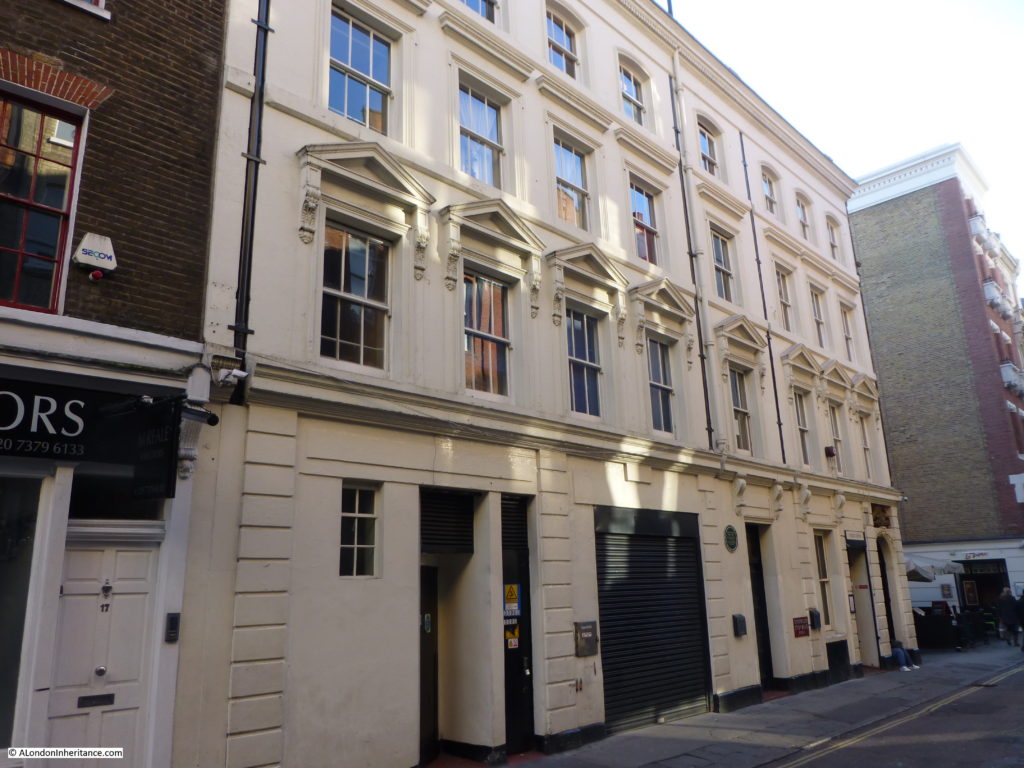
The Maiden Lane entrance in the photo above. The ghost of William Terris is alleged to haunt the Adelphi and the nearby Covent Garden underground station.
There is a plaque to William Terriss at the rear of the Adelphi in Maiden Lane.
The Adelphi Theatre is currently showing Kinky Boots.
Vaudeville Theatre
A short distance further along the Strand is the Vaudeville Theatre:
The Vaudeville Theatre was originally built in 1870 with a narrow entrance onto the Strand as there were originally two houses on the site facing onto the Strand. These two houses were demolished in 1889 and replaced by the facade of the theatre. The exterior view of the Vaudeville has only had minor changes since.
The theatre has hosted an almost continuous run of productions since opening, and as far as I can tell has retained the original name.
The Vaudeville Theatre is currently hosting Stepping Out.
The Savoy Theatre
On the opposite side of the Strand can be found the Savoy Theatre, somewhat concealed alongside the entrance to the Savoy Hotel.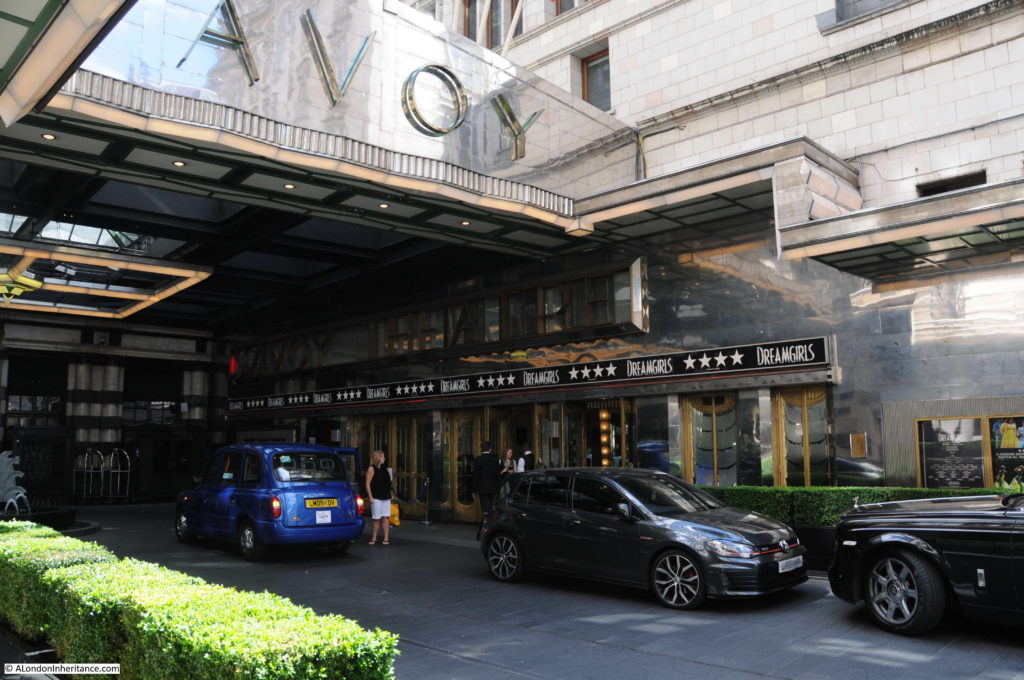
The Savoy Theatre was opened in 1881, eight years earlier than the adjacent, much larger, Savoy Hotel. Both the theatre and the hotel were built by Richard D’Oyly Carte.
The interior of the theatre has been through a number of major rebuilds and restorations including after a major fire in 1990 which resulted in the closure of the theatre for just over three years.
The best view of the size of the Savoy Theatre is through a short walk down Carting Lane where the large size of the theatre, which has a seating capacity of 1,158, can be appreciated.
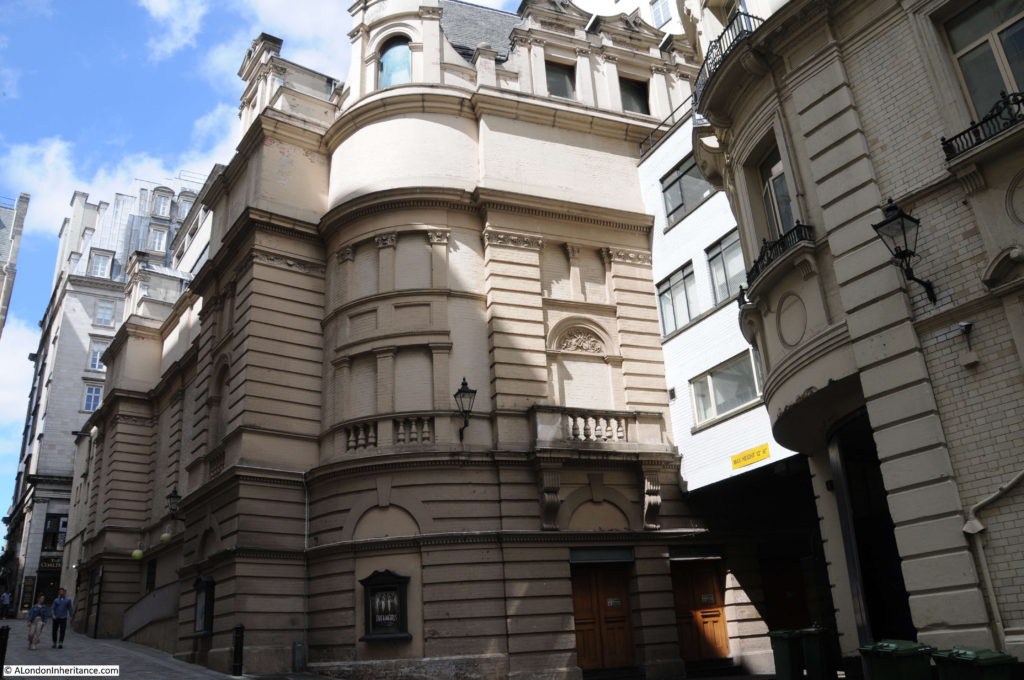
The Savoy Theatre was also the first public building to be lit by electricity, a fact recorded on a plaque on the side of the theatre in carting Lane.
The stage door entrance to the Savoy Theatre in Carting Lane.
The Savoy Theatre is currently showing Dreamgirls.
The Lyceum Theatre
North of the junction of the Strand and the approach to Waterloo Bridge is Wellington Street and a short distance along is the Lyceum Theatre:
The Lyceum Theatre was opened in 1834 with the name Theatre Royal Lyceum and English Opera House. The main body of the theatre was rebuilt in 1904 retaining only the facade and the large portico and the theatre continued to run until 1939 when it was purchased by the London County Council who intended to demolish the theatre to make way for road improvements.
The timing of the purchase resulted in nothing happening to the building due to the outbreak of war and following the war the original plans were abandoned.
The theatre was empty until 1951 when it reopened as the Lyceum Ballroom having been converted into a large ballroom. The Lyceum Ballroom would go on to host pop concerts throughout the 1960s, 70s and early 1980s for bands such as The Who, Emerson, Lake and Palmer and Genesis.
Closing again in 1986, it did not reopen until 1996 following a significant restoration project to return the building to a theatre capable of staging large scale musicals, a function it has performed ever since.
View of the Lyceum Theatre from the junction of Wellington and Exeter Streets showing the large size of the theatre which has a seating capacity of 2,100.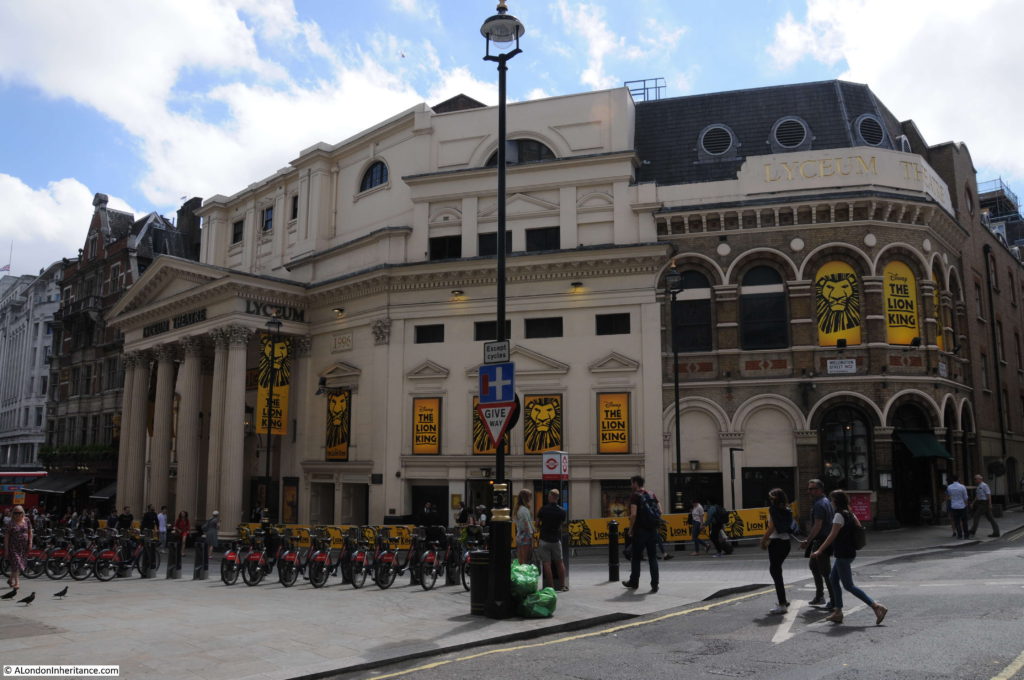
The Lyceum Theatre is currently showing The Lyon King which has been playing at the theatre since 1999.
The Novello Theatre
At the junction of Catherine Street and Aldwych is the Novello Theatre: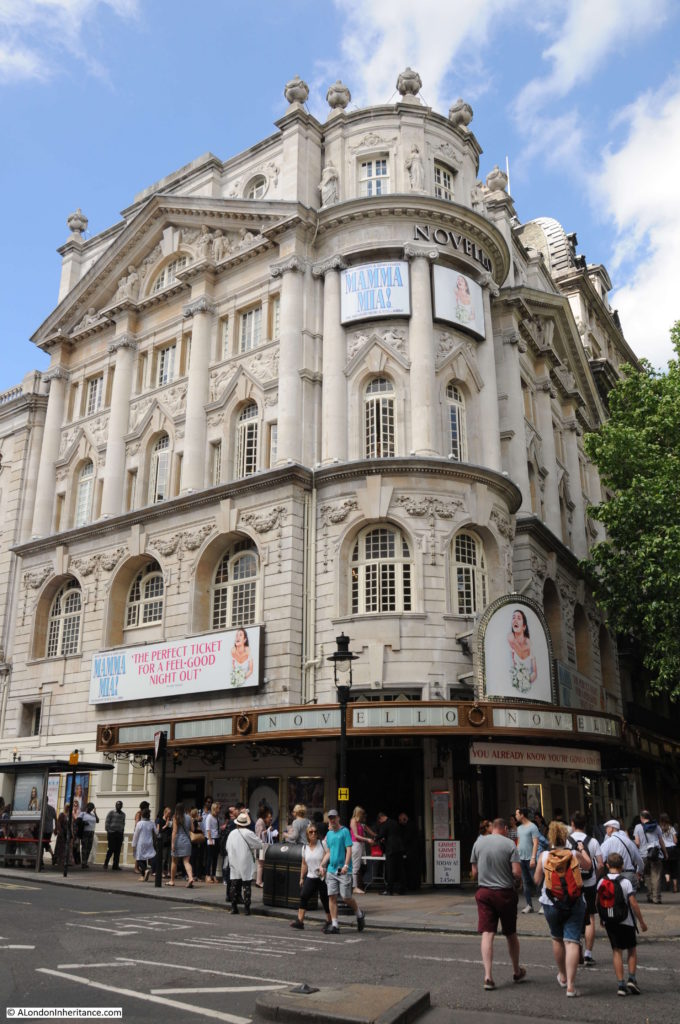
The Novello Theatre was originally opened in 1905 as the Waldorf Theatre, becoming the Strand Theatre in 1913.
The theatre was hit by bombs from a Zeppelin during a raid on London on the 13th October 1915 and although there was some damage to the theatre, it continued in operation with the production that night of the Scarlet Pimpernel. The theatre would also suffer some damage in 1940.
The theatre continued with the name of the Strand Theatre until 2005 when after a major refurbishment it reopened with the new name of the Novello Theatre in honour of the composer and actor Ivor Novello who lived in a flat above the theatre from 1913 until his death in 1951.
The Novello Theatre is currently hosting Mama Mia.
The Duchess Theatre
A short distance along Catherine Street from the Novello, is the Duchess Theatre: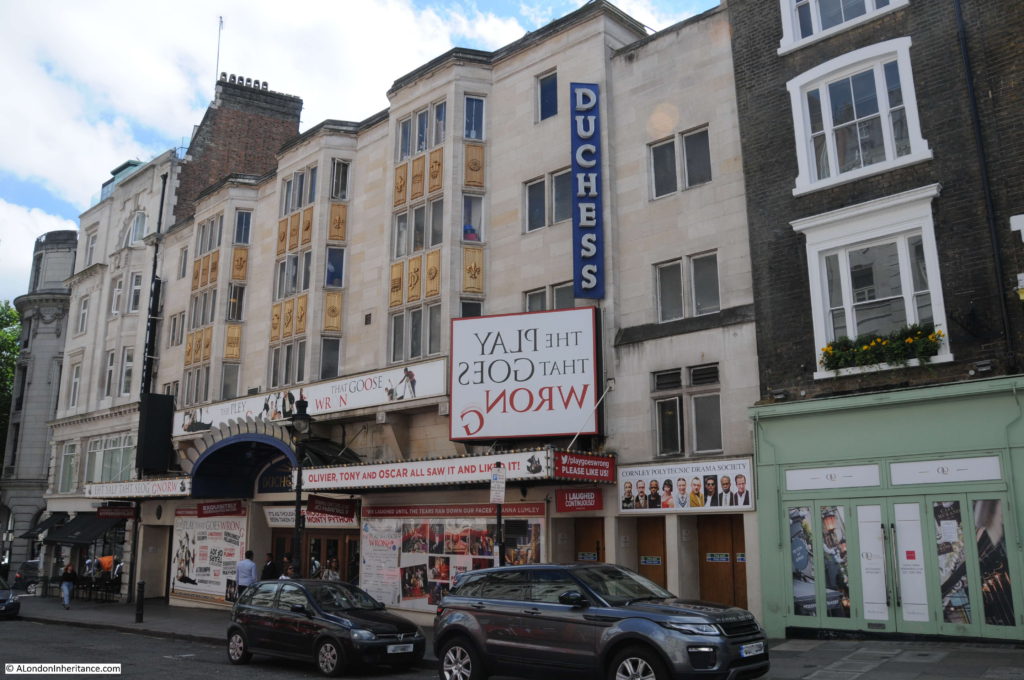
The Duchess Theatre opened in 1929 and is one of the West End’s smaller theatres with seating for 494.
The theatre has seen an almost continuous run of productions and also appears to have retained the original name since the theatre opened.
The Duchess Theatre is the location of the shortest run for a West End production. On the 30th Match 1930 the first staging of “The Intimate Revue” was taking place, however as some scene changes were taking upwards of 20 minutes, a number of scenes were abandoned allowing the finale to be completed by midnight. The Intimate Revue did not have a second night and as several scenes were abandoned during the first night, technically it did not even complete a first night.
Perhaps appropriately, the Duchess Theatre is currently hosting The Play That Goes Wrong.
Theatre Royal, Drury Lane
At the junction of Catherine Street and Russell Street is the Theatre Royal, Drury Lane: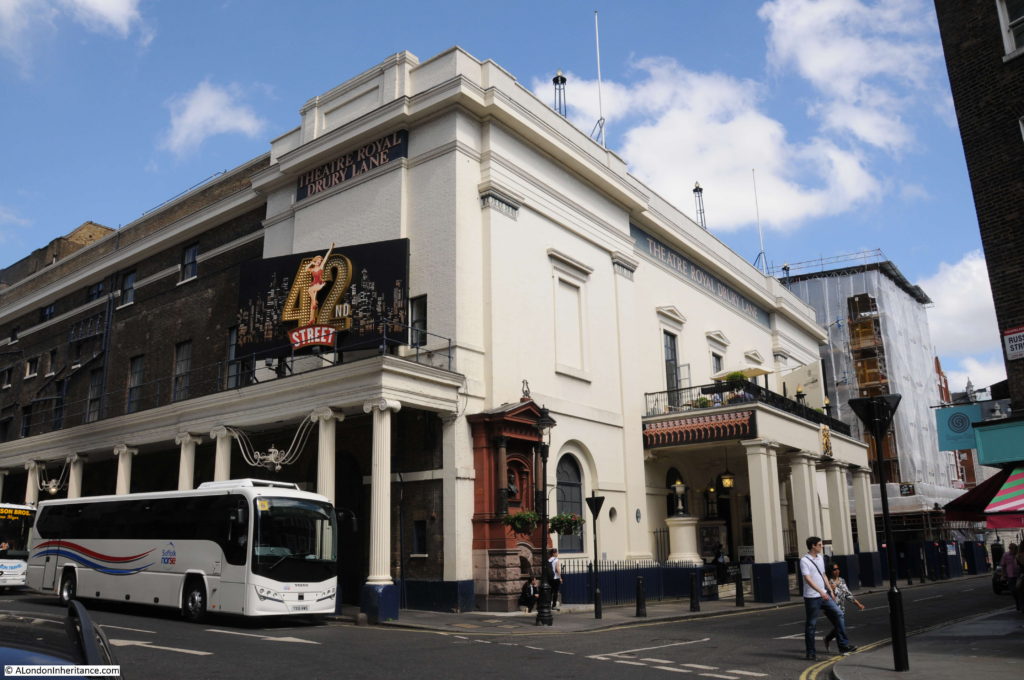
There has been a theatre on the site of the Theatre Royal for centuries. The first theatre was built by Thomas Killigrew in 1663 who had received a Royal Charter from King Charles II.
Killigrew replaced the original theatre with a second to occupy the site in 1674 and this building lasted until the third theatre building to occupy the site was constructed in 1794, designed by Henry Holland and with a capacity for 3,600 people.
The third version of the theatre was destroyed by fire in 1809, following which the final version of the theatre which we see today was built and opened in 1812.
The portico on the front of the building was an addition in 1820, and the long side colonnade along Russell Street was an addition in 1831.
The following print of the Theatre Royal, Drury Lane is from 1828, three years before the side colonnade was added.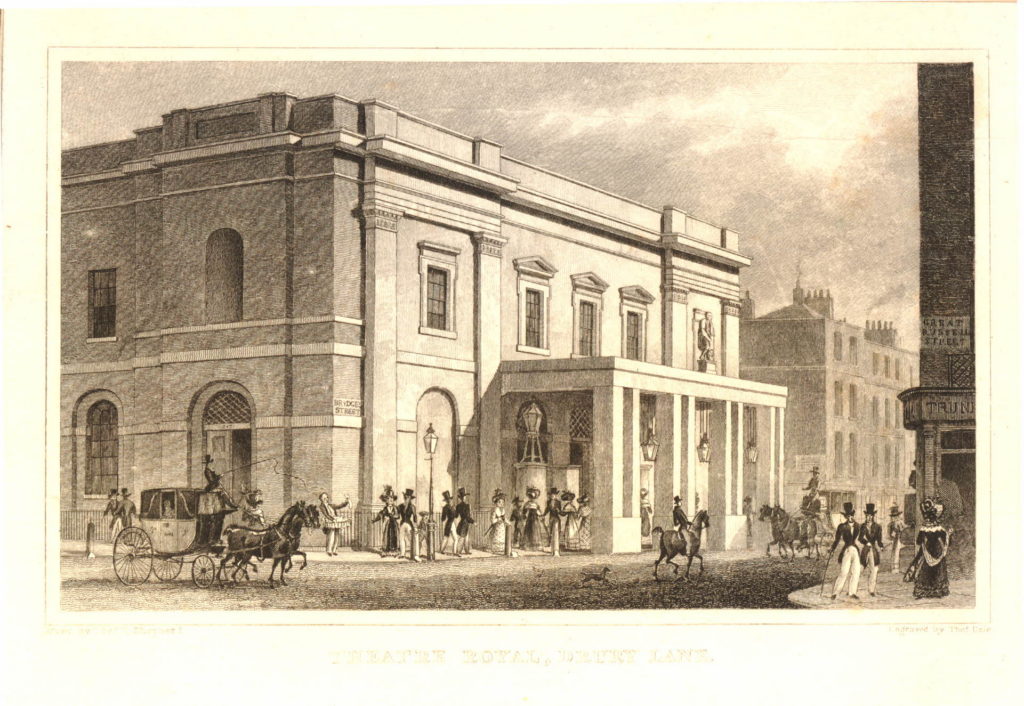
The Theatre Royal, Drury Lane was the location of an assassination attempt on King George III in 1800.
The King was in the royal box in the theatre on the evening of the 15th May 1800, when during the singing of the national anthem, James Hadfield who was in the stalls, fired a pistol at the King.
Fortunately for both the King and Hadfield he missed. He was tried for high treason, but pleaded insanity. He had suffered a number of previous war injuries to the head, and it was these that supported his plea of insanity. He was acquitted of the charge, but was detained indefinitely in the Bedlam Hospital after the Criminal Lunatics Act was swiftly passed by parliament in 1800 in reaction to Hadfield’s trial and acquittal. He did have a brief period of freedom following an escape, but was quickly recaptured and lived for 41 years following his attempt on the King’s life, dying of tuberculosis in 1841.
The Canterbury Journal reported from George’s Coffee House that:
“Hadfield is cleared, it being fully proved that he was insane at the time he committed the offence of firing at the King. The trial commenced at nine o’clock this morning and ended between three and four. the Attorney General not being prepared to annul the insanity of the prisoner the court recommended the Jury to acquit him”
Print of the assassination attempt: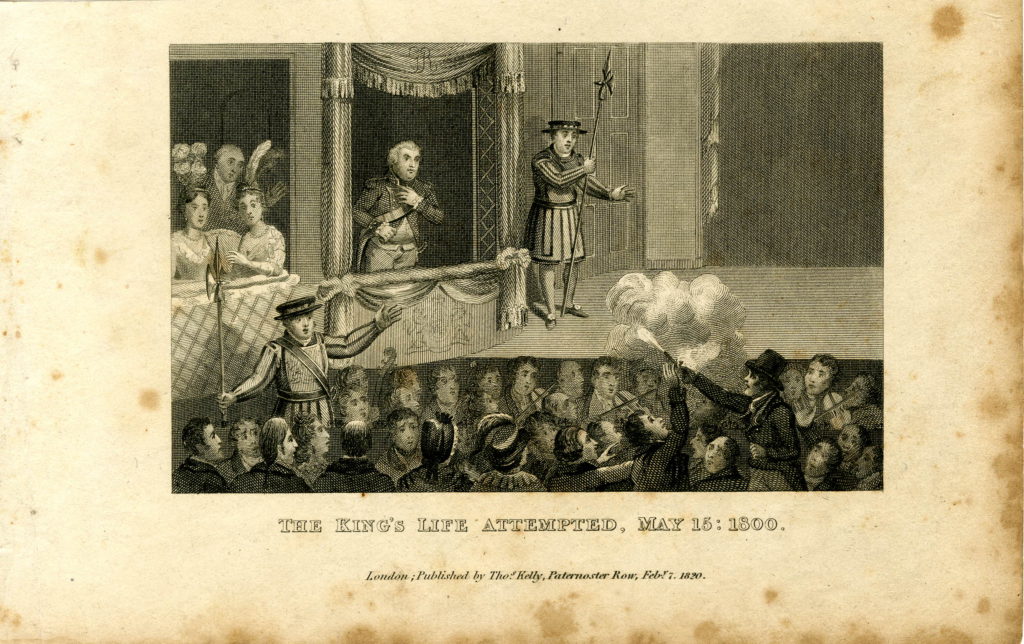
There is a memorial fountain to Augustus Harris on the front of the theatre. Harris was responsible for the theatre from 1879 to 1896, and during his tenure he put on a wide range of plays and pantomimes. The success of his pantomimes was considerable and they starred many of the musical hall stars of the day.
After his death, public subscriptions provided for the memorial fountain which was unveiled in 1897.
Music cover for the “The Pantomime Quadrille” dedicated to Augustus Harris with a photo of Harris who died at the relatively young age of 44.
Walking along the Russell Street side of the Theatre Royal, I found a couple of parish boundary markers, the first I have seen on a theatre. The marker on the left is St. Martin in the Fields, and on the right is St. Paul Covent Garden. Note the original boundary marking painted on the brickwork for St. Paul.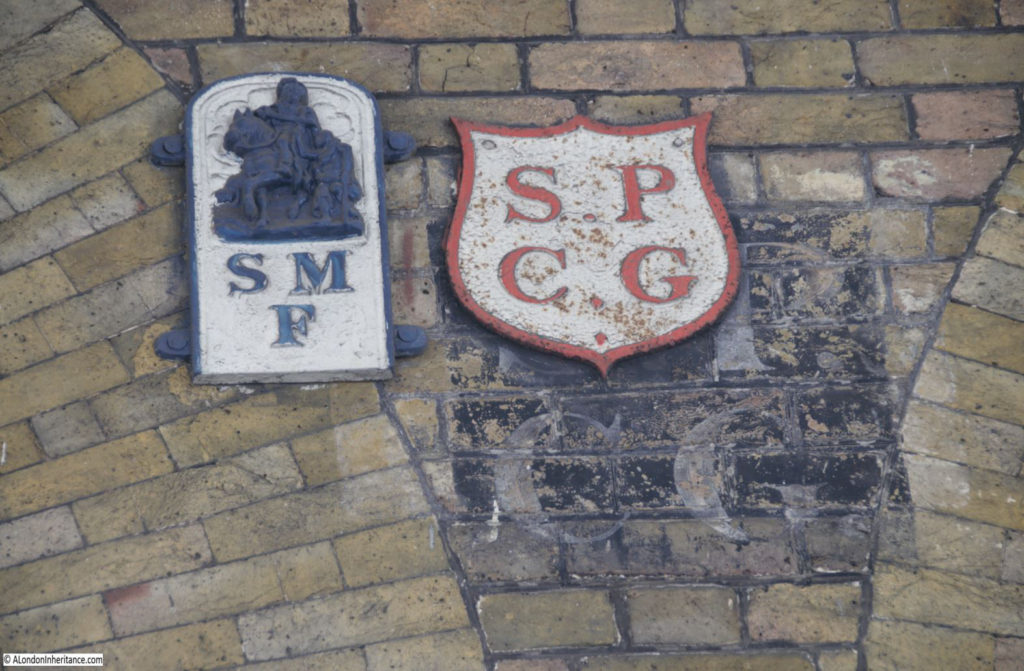
Stage door for the Theatre Royal, Drury Lane: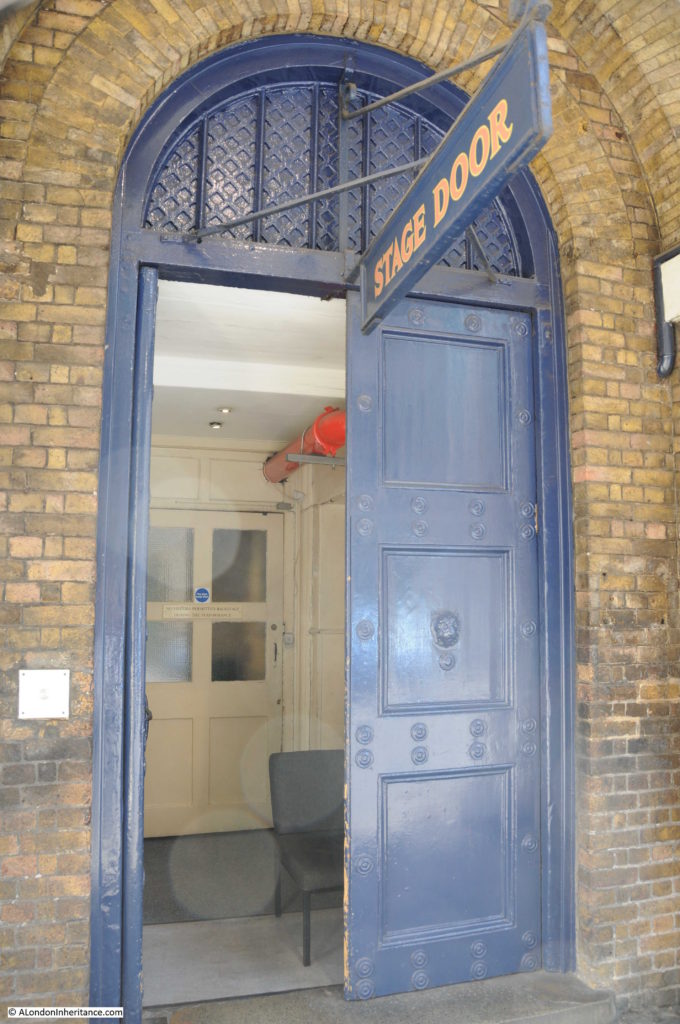
The Theatre Royal, Drury Lane is currently showing 42nd Street.
Fortune Theatre
In Russell Street, opposite the side of the Theatre Royal, Drury Lane is the Fortune Theatre: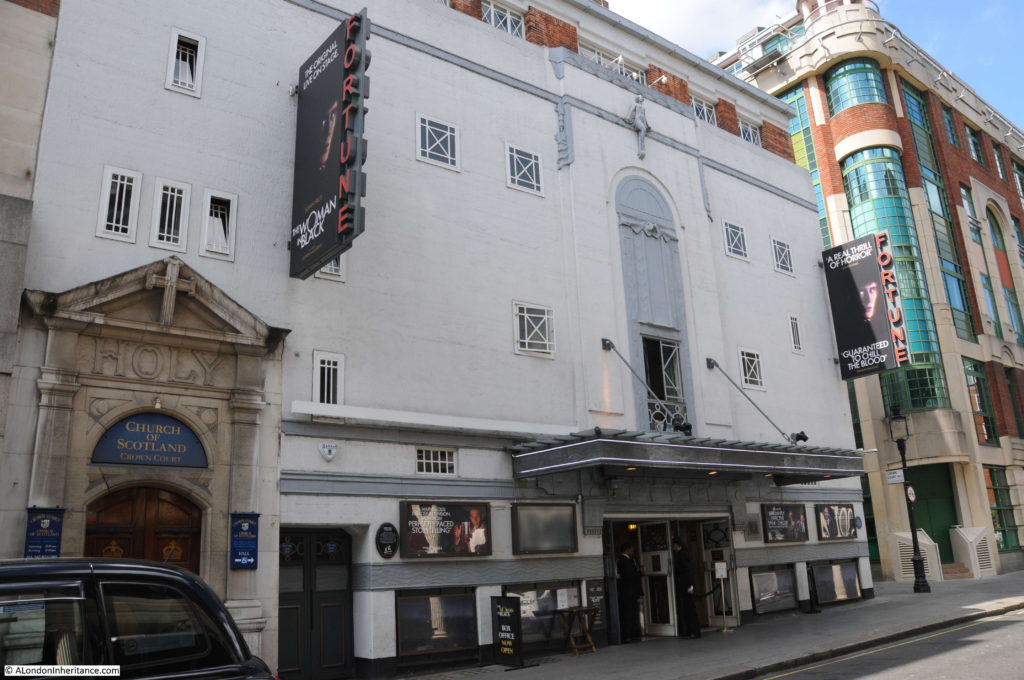
The Fortune Theatre opened in November 1924 and is one of the West End’s smaller theatres with a capacity of 432. As far as I can tell, the theatre has retained its original name and has had an almost continuous run of productions since opening.
The facade of the theatre is mainly of concrete and high above the main entrance is a sculpture of Terpsichore (one of the nine muses in Greek mythology with an emphasis on dance). The sculpture was created by the arts and crafts artist M. H. Crichton.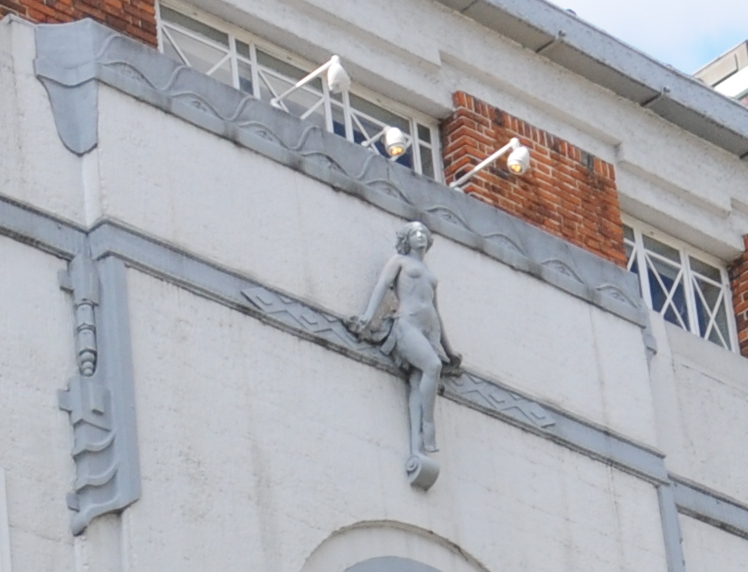
The facade of the theatre is also shared by an entrance to a church which looks rather out of place in the lower left corner of the facade. The entrance is to the Crown Court Church of Scotland, a Presbyterian church that has been here since 1719. The original church was replaced in 1909 so the current church predates the Fortune Theatre which must have integrated the entrance to the church within the new facade of the theatre in 1924.
The Fortune Theatre is currently hosting The Woman In Black
Aldwych Theatre
From Russell Street, turn right down Drury Lane to the junction with Aldwych where on the corner is to be found the Aldwych Theatre: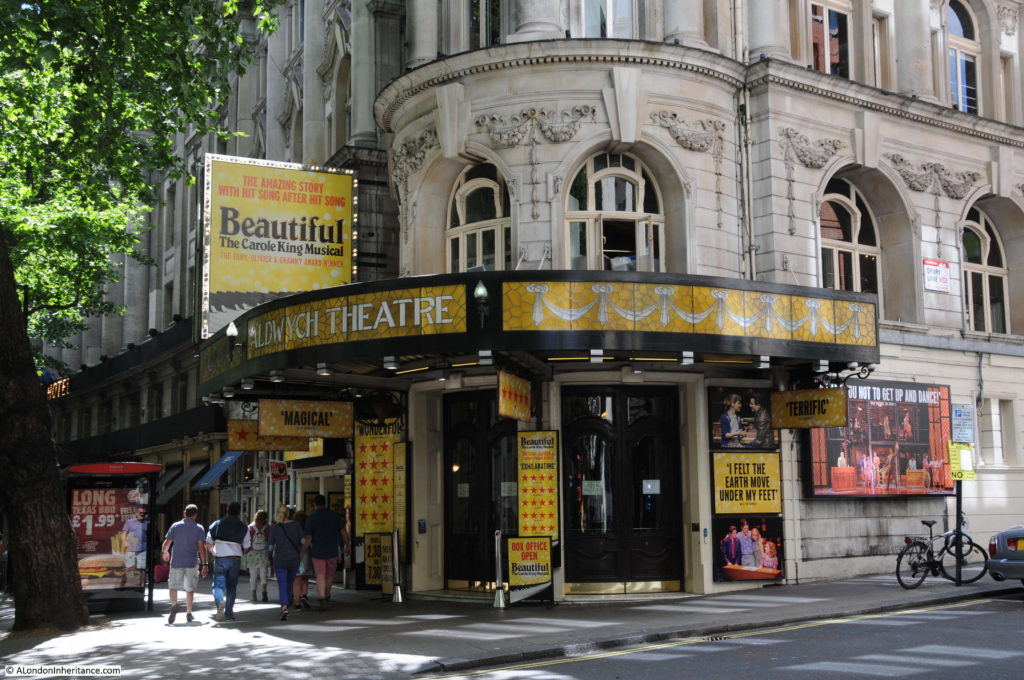
The Aldwych Theatre was built in 1905 at the same time and to the same design by the architect W. G. R. Sprague as the Novello Theatre which I visited earlier in this post.
Unlike the Novello, the Aldywych Theatre has retained the original name, and has seen an almost continuous run of productions, including a twenty one year period from 1960 when the Royal Shakespeare Company were in residence at the Aldwych.
The stage door of the Aldwych Theatre. Whilst the main frontage of the theatre onto Aldwych is of stone, the side walls of the theatre in which the main body of the auditorium and stage are located were built of brick to save money.
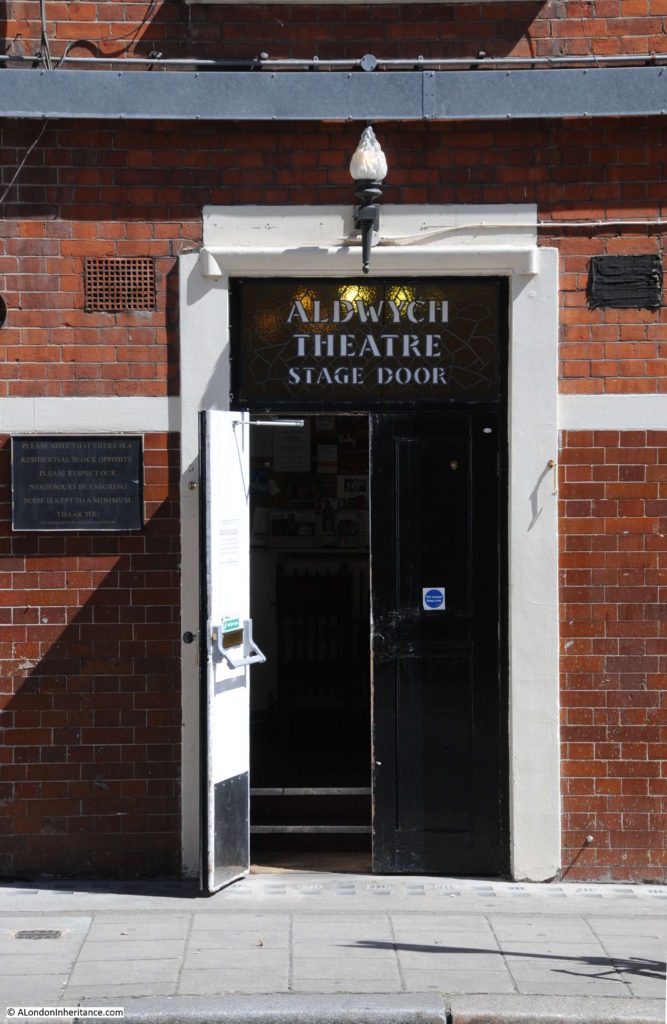
The Aldwych Theatre is currently showing Beautiful – The Carole King Musical
The London Palladium
For my final theatre visit, I walked back along the Strand to Charing Cross to catch a Bakerloo train up to Oxford Circus to visit the theatre at the north west corner of my boundary of West End theatres, the London Palladium in Argyll Street:

The Palladium dates from the turn of the century expansion of West End theatres having opened in 1910 on the former site of Argyll House.
Argyll House was built on land owned by the Duke of Argyll by his younger brother Lord Ilay. Construction started in 1737 and continued with the addition of various rooms and extensions for the next couple of decades.
Lord Ilay became the Duke of Argyll following the death of his older brother and the house passed down the Argyll family until being sold in 1808 to the Earl of Aberdeen. The house was sold in 1862 by the Earl of Aberdeen’s son, the last nobleman’s town house to survive in the area around Oxford Circus and Regent’s Street.
Argyll House as it appeared in 1854 from a drawing by Thomas Hosmer Shepherd.

It was demolished soon after and over much of the site was built the Corinthian Bazaar and Exhibition Rooms.
The majority of the Corinthian Bazaar was demolished to make way for the Palladium, however the facade onto Argyll Street, although modified, is from the original Bazaar building.
The facade looks as if the theatre is directly behind, however it is an L shaped theatre with the entrance providing access to the rear of the auditorium which then runs to the stage behind the buildings down Argyll Street to the right of the main entrance.
The Palladium has hosted a wide range of events over the years, including plays and musicals, but has also hosted TV programmes such as Sunday Night at the London Palladium, many of the Royal Variety Performances, variety from performers such as Ken Dodd and Bruce Forsyth and shows by stars such as Frank Sinatra, Judy Garland, Bob Hope Max Bygraves, Julie Andrews and Cilla Black.
On the day of my visit, the Saturday 27th May 2017, the London Palladium was hosting one night of Simple Minds Acoustic 2017 tour.
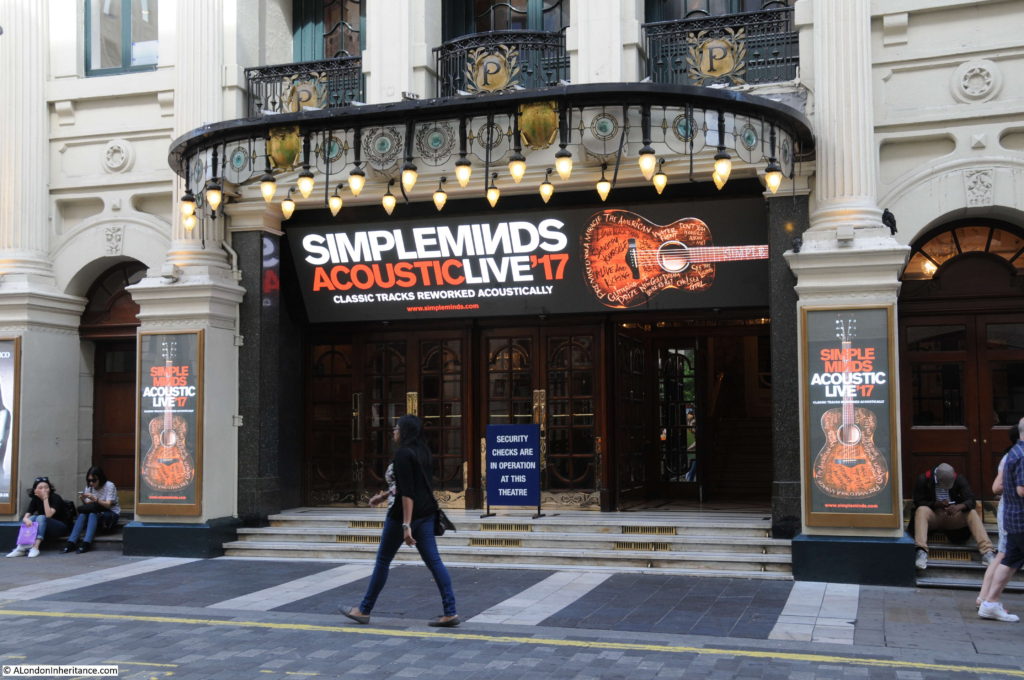
And the London Palladium concludes my walk around the theatres of London’s West End for a snapshot of their history, appearance and productions on Saturday 27th May 2017.
In my two posts I have covered 41 theatres within my definition of the West End. I knew there were many theatres, but did not realise quite how many and I may have missed a couple of smaller theatres (please let me know if there are any I have missed).
I have only scratched the surface of their long and fascinating history and it is good to see buildings that are often over one hundred years old, with the earliest occupying theatrical sites that date back to the 17th century, still playing such an active part in the cultural and commercial life of the city.
They have survived threats from new forms of entertainment during their time, such as the cinema and television and still appear to be in fine health. The Society of London Theatre’s 2016 Box Office report stated that:
- Gross revenue of £644,719,639
- Attendances of 14,328,121
- Weekly attendance set a new record during week commencing the 26th December 2016 at 439,103
The report also records that audiences have risen from 10,236,362 in 1986 to 14,328,121 in 2016 and that 44 was the average number of theatres open in 2016 (numbers have stayed reasonably static over the past 30 years). The number was slightly higher than my 41 theatres but may be due to slightly different geographic scope, or maybe I did indeed miss a couple.
It was a fascinating theme for a walk. The warm weather dictated a couple of stops at pubs along the way, which is perhaps a theme for a future walk around London, although I fear that the longevity of these will not be as good as the theatres of the West End.
alondoninheritance.com




